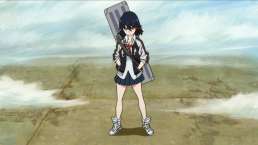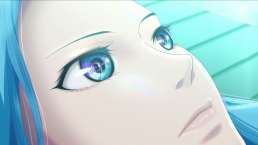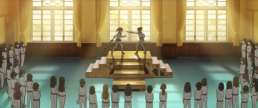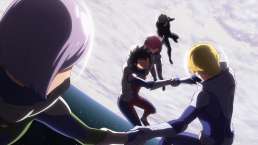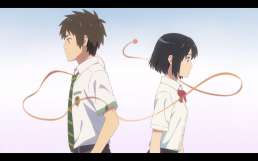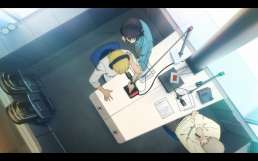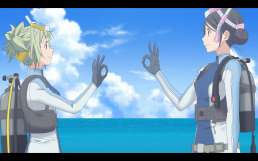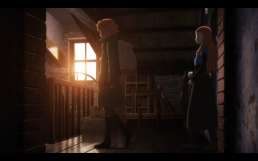Review: Girls Band Cry
In Short:
Girls Band Cry is a 13 episode anime from 2024 made by Toei Animation that follows five girls as they try and come together as a professional independent rock band. It’s five main characters are all quirky and real with their own hangups and somewhat troubled pasts they work to overcome. While there is some serious drama, the show avoids becoming gritty or depressing. Instead, it’s a delight to see these characters squabble and fight and bounce off each other but still become good friends in the end.
Suggested Minimum Watch: 1 episode. While you don’t really meet the full set of main characters till roughly the midway point, episode 1 does a good job showcasing the show’s style of drama, humor, quirkiness, and features a strong showing of its approach to its tightly produced Rock n’ Roll musical numbers. If you like the first episode, you’ll like the rest of the show.
Full Review:
 I almost didn’t watch Girls Band Cry because of the way it debuted and because of the way I approach music. For me, music is something that has to be connected to other things. I’ll enjoy the heck out of songs if they are connected to a show or movie or even just a moment in life that I love, but I almost never seek out music for its own sake. So when Girls Band Cry started by first releasing music videos almost a year before the anime came out I pretty much ignored the songs and didn’t plan on watching the anime. The music alone just didn’t mean anything to me. But then, a year later, I happened to give the first episode of the anime a chance and was hooked! Perhaps it’s not my favorite anime of all time, but I consider it one of my standouts in recent years.
I almost didn’t watch Girls Band Cry because of the way it debuted and because of the way I approach music. For me, music is something that has to be connected to other things. I’ll enjoy the heck out of songs if they are connected to a show or movie or even just a moment in life that I love, but I almost never seek out music for its own sake. So when Girls Band Cry started by first releasing music videos almost a year before the anime came out I pretty much ignored the songs and didn’t plan on watching the anime. The music alone just didn’t mean anything to me. But then, a year later, I happened to give the first episode of the anime a chance and was hooked! Perhaps it’s not my favorite anime of all time, but I consider it one of my standouts in recent years.
Girls Band Cry follows in the footsteps of Sound! Euphonium and A Place Further than the Universe in that all three are shows whose stories and characters were penned by Jukki Hanada. His style of writing that puts the personalities and actions of characters at the forefront just clicks with me. Characters’ good times and bad, their delights and dilemmas, their strengths and weaknesses, they all flow together that makes so many of his shows among my favorites.
For Girls Band Cry, we have five main characters who have each set out on their own in life for their own highly personal reasons.
 Our main viewpoint character is Nina Iseri. Early on, we learn she was plagued by some sort of bullying incident in high school and because it she convinced her parents to let her drop out and move away to Tokyo to live and study on her own for college. Nina can be sweet and devoted, but just as often she can be prickly, stubborn, and a lot to deal with.
Our main viewpoint character is Nina Iseri. Early on, we learn she was plagued by some sort of bullying incident in high school and because it she convinced her parents to let her drop out and move away to Tokyo to live and study on her own for college. Nina can be sweet and devoted, but just as often she can be prickly, stubborn, and a lot to deal with.
On her first bumbled day in the big city, Nina comes across a musician a few years older than her named Momoka Kawaragi. It turns out it was Momoka’s hit song “Void” that helped Nina get through the worst of her bullying. We soon learn that Momoka, for her own reasons, left her rising star of a band Diamond Dust and has tried but largely failed to strike out on her own. She lost things she didn’t expect when she left her band and she’s been unable to find them again.
 These two strike up a friendship with Momoka doing her best to pull the uncooperative Nina into a new band along with drummer Subaru Awa. Sabaru is an energetic delight, but she too wishes to strike out on her own. For her, it’s to buck the expectations one prominent member of her family has for her. Subaru wants the freedom to do her own thing, but knows she’ll hurt at least one of her most supportive family members when she does so.
These two strike up a friendship with Momoka doing her best to pull the uncooperative Nina into a new band along with drummer Subaru Awa. Sabaru is an energetic delight, but she too wishes to strike out on her own. For her, it’s to buck the expectations one prominent member of her family has for her. Subaru wants the freedom to do her own thing, but knows she’ll hurt at least one of her most supportive family members when she does so.
 Later on, these three are joined by Tomo Ebizuka and Rupa. Like Subaru, Tomo is a girl roughly Nina’s age whose family let her down, so she left them behind. She is serious about making music her career, but struggles to work with those less serious than herself. Rupa, who is Tomo’s roommate, has her own sad past and, as a girl of mixed race, lives in a sometimes unpleasant present. So Rupa, like the others, has some reasons to let out her frustrations on a rock band stage.
Later on, these three are joined by Tomo Ebizuka and Rupa. Like Subaru, Tomo is a girl roughly Nina’s age whose family let her down, so she left them behind. She is serious about making music her career, but struggles to work with those less serious than herself. Rupa, who is Tomo’s roommate, has her own sad past and, as a girl of mixed race, lives in a sometimes unpleasant present. So Rupa, like the others, has some reasons to let out her frustrations on a rock band stage.
The ways these five fit together, or rather the ways they sometimes don’t, is what makes the show. Momoka pulls the five of them into her new band but then hesitates as things start to get real. Nina is constantly a lovable pain in the ass with the way she stubbornly rejects genuine offers of help or friendship. Subaru has to hide her identity on stage for fear of disappointing her family. Tomo thinks she’ll drive everyone away if she voices her real opinions on the others’ levels of skill and commitment, etc. The arguments and honest conversations that come out of these conflicting wants and needs can be fiery, but as Momoka explains early on, some of her best memories of being in a band were the fights with her friends. And so it is with the anime.
 The five girls eventually settle down, learn each others habits and hangups, and do come together. There is drama here, but it’s not as heavy as the classic rock band anime NANA, for instance. Girls Band Cry remains generally lighthearted and while some situations can comes as a shock or take multiple episodes to resolve, the girls do eventually resolve them. The writing here is excellent. The personalities feel real. There’s some humor along the way, but it’s humor that fits in with the show instead of humor that is the show.
The five girls eventually settle down, learn each others habits and hangups, and do come together. There is drama here, but it’s not as heavy as the classic rock band anime NANA, for instance. Girls Band Cry remains generally lighthearted and while some situations can comes as a shock or take multiple episodes to resolve, the girls do eventually resolve them. The writing here is excellent. The personalities feel real. There’s some humor along the way, but it’s humor that fits in with the show instead of humor that is the show.
Animation and Music:
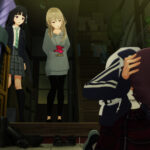 Girls Band Cry is a 3d CGI production, meaning most everything except the rare one off background character is done as computer animation. While the show generally lacks the overwhelmingly rich level of foreground and background detail something like a full blown Disney/Pixar movie has, Girls Band Cry does have its own strengths that become more apparent the more you watch. The show features a smooth, constant, 24 frames per second rate of animation. A lot of hand-drawn and CGI anime updates less frequently where Girls Band Cry updates the movements of its camera and characters every frame. In practice what this mean is every scene has something happening. Every character movement is smooth and detailed. From big sweeping gestures to the show’s frequent use of highly expressive facial reactions, everything is snappy and fluid in ways you might not expect from most 3d productions. Or from most traditional, hand-drawn anime for that matter.
Girls Band Cry is a 3d CGI production, meaning most everything except the rare one off background character is done as computer animation. While the show generally lacks the overwhelmingly rich level of foreground and background detail something like a full blown Disney/Pixar movie has, Girls Band Cry does have its own strengths that become more apparent the more you watch. The show features a smooth, constant, 24 frames per second rate of animation. A lot of hand-drawn and CGI anime updates less frequently where Girls Band Cry updates the movements of its camera and characters every frame. In practice what this mean is every scene has something happening. Every character movement is smooth and detailed. From big sweeping gestures to the show’s frequent use of highly expressive facial reactions, everything is snappy and fluid in ways you might not expect from most 3d productions. Or from most traditional, hand-drawn anime for that matter.
And this is surprising. At lot of 3d rendered shows skimp on this. Expressions often remained static and unchanging. Characters movements are sometimes jerky or or unnaturally stiff, especially when they aren’t the center of attention. Not so in Girls Band Cry. Its animation is actually really good! And consistently so! Which must have taken a ton of work all for a new, unknown, original anime based on nothing before it. There is no hundred issue manga funding this show.
 Finally, beyond the well-written characters and consistently good animation, there’s the rock music and the music sequences. Girls Band Cry’s music is influenced a lot by Nina’s experiences with bullying and feeling cut off. She sings about making tough choices. About feeling alone in crowds. About how patronizing it can be to tell someone to do their best but then tell them to fit in. And all this is held up by some of the very best music video type sequences in anime. There’s breathtakingly good motion capture of the girls playing instruments and singing. There’s fun, creative camera moves that pan, and snap and rotate and spin to the beat of the music.
Finally, beyond the well-written characters and consistently good animation, there’s the rock music and the music sequences. Girls Band Cry’s music is influenced a lot by Nina’s experiences with bullying and feeling cut off. She sings about making tough choices. About feeling alone in crowds. About how patronizing it can be to tell someone to do their best but then tell them to fit in. And all this is held up by some of the very best music video type sequences in anime. There’s breathtakingly good motion capture of the girls playing instruments and singing. There’s fun, creative camera moves that pan, and snap and rotate and spin to the beat of the music.
 There’s a variety of cool effects from raindrops hanging in the air to pretend glass walls shattering as they are referenced in the lyrics, to the momentary color inversions during one particularly awesome guitar solo. These sequences generally serve as rewarding ends to episodes. Some are high flying moments, others are yelling about injustices in the world through song, but they’re all brilliant showpieces of music and animation working hand in had.
There’s a variety of cool effects from raindrops hanging in the air to pretend glass walls shattering as they are referenced in the lyrics, to the momentary color inversions during one particularly awesome guitar solo. These sequences generally serve as rewarding ends to episodes. Some are high flying moments, others are yelling about injustices in the world through song, but they’re all brilliant showpieces of music and animation working hand in had.
All In All
 Girls Band Cry is about learning to be yourself, learning when to reject help and when to accept it, learning how to fit in with others and address their wants and their fears alongside your own. And it’s about these five girls supporting each other and combining their strengths to accomplish something bigger than their individual selves. It’s fun and entertaining rather than being heavy and depressing, but it is not a comedy-first show the likes of K-On! or Bocchi The Rock!. Aside from its showcase on-stage rock sequences, it doesn’t necessarily do anything never seen before. If you’ve watched NANA, K-On!, Bocchi the Rock, Ya Boy Kongming, and other music anime then you’ve seen a lot of the building blocks that Girls Band Cry draws upon, but it combines them with good character writing in fun ways that ended up making it one of my favorite anime of 2024.
Girls Band Cry is about learning to be yourself, learning when to reject help and when to accept it, learning how to fit in with others and address their wants and their fears alongside your own. And it’s about these five girls supporting each other and combining their strengths to accomplish something bigger than their individual selves. It’s fun and entertaining rather than being heavy and depressing, but it is not a comedy-first show the likes of K-On! or Bocchi The Rock!. Aside from its showcase on-stage rock sequences, it doesn’t necessarily do anything never seen before. If you’ve watched NANA, K-On!, Bocchi the Rock, Ya Boy Kongming, and other music anime then you’ve seen a lot of the building blocks that Girls Band Cry draws upon, but it combines them with good character writing in fun ways that ended up making it one of my favorite anime of 2024.
Review: Akebi's Sailor Uniform Anime
In Short:
Released in 2022 by CloverWorks, Akebi’s Sailor Uniform is a twelve episode anime based on a manga of the same name. It follows twelve year old Komichi Akebi as she starts her first year of junior high at the same all girls private academy that her mother attended several years before. All throughout elementary school Komichi was the only student in her class, so she is beyond thrilled to finally be able to make friends with girls her own age.
Due to an odd mix up, neither Komichi nor her mother realized that the school recently changed its dress code from the bright white sailor-style uniforms Komichi’s mother wore to more modern dress shirts and dark navy blazers. This leaves Komichi as the one girl at her new school who is dressed differently from everyone else. Fortunately, Komichi’s athleticism, endlessly cheerful attitude, and occasional quirkiness help her quickly become the most popular girl in school as she befriends the fifteen other girls in her homeroom class.
Suggested Minimum Watch: 2 Episodes. The first episode largely covers the lead up to getting Komichi to her new school. The second episode, where Komichi first begins to really interact with her classmates, more closely resembles the flow of the rest of the series.
Full Review:
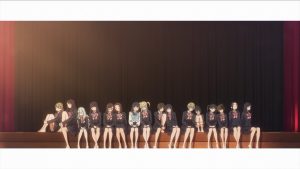 I was initially a little confused when I heard that the opening song to Akebi’s Sailor Uniform featured the voice actresses of all sixteen members of Komichi’s homeroom class. Having now finished the show, it strikes me as a perfect choice, and one that immediately reflects what the show is all about.
I was initially a little confused when I heard that the opening song to Akebi’s Sailor Uniform featured the voice actresses of all sixteen members of Komichi’s homeroom class. Having now finished the show, it strikes me as a perfect choice, and one that immediately reflects what the show is all about.
The song fits so well because Akebi’s Sailor Uniform strives to give life to every member of Komichi’s class. Each one of these girls is more than just a few facts on a fan wiki. They each have their own lifelike personalities that are slowly revealed during the course of the anime. By the end of the series I had come to know more about each of these sixteen girls and can now tell you at least one noteworthy scene each of them features in.
 For instance, take Toko Usagihara who sits at the desk behind Komichi and is practically the visual and emotional reincarnation of Ritsu Tainaka from K-On! She is someone who is goofy and who loves to mildly tease others, but also someone who enjoys delighting her friends with good-natured surprises. We find that she is actually a bit jealous of Komichi, but she quickly puts that aside to become perhaps the best supporting character in the series.
For instance, take Toko Usagihara who sits at the desk behind Komichi and is practically the visual and emotional reincarnation of Ritsu Tainaka from K-On! She is someone who is goofy and who loves to mildly tease others, but also someone who enjoys delighting her friends with good-natured surprises. We find that she is actually a bit jealous of Komichi, but she quickly puts that aside to become perhaps the best supporting character in the series.
Or, take Riri Minakami, the blond-haired girl that sits on the opposite side of the room from Komichi. She’s an award-winning athlete and someone who is fiercely competitive in most everything she does. She’s also perfectly happy to annoy her fellow classmates if it gets them to interact with her. At one point, she makes a bet with Komichi that leads to one of the most tension filled episodes in this notably low tension series.
 And then there’s Komichi herself. She is this incredible bundle of non-stop energy who tries her absolute best at everything she does. Yes, she’s a little quirky, and a little naive. In some ways, because she lives in a rural area without anyone to interact with other than her mother, father, and adorable little sister, she is just a bit of a country bumpkin. But, to her credit, Komichi is so friendly with and so accepting of her peers that they can’t help but admire her. Her athleticism and generally good grades don’t hurt her any, either. Komichi’s homemade sailor uniform may be the easiest way to pick her out of a crowd at school, but it’s her personality that wins her an entire class of friends.
And then there’s Komichi herself. She is this incredible bundle of non-stop energy who tries her absolute best at everything she does. Yes, she’s a little quirky, and a little naive. In some ways, because she lives in a rural area without anyone to interact with other than her mother, father, and adorable little sister, she is just a bit of a country bumpkin. But, to her credit, Komichi is so friendly with and so accepting of her peers that they can’t help but admire her. Her athleticism and generally good grades don’t hurt her any, either. Komichi’s homemade sailor uniform may be the easiest way to pick her out of a crowd at school, but it’s her personality that wins her an entire class of friends.
One of the things this anime excels at is creating memorable moments of interaction between its characters. Their dialogue. Their actions. Everything just sorta works together to make these characters feel authentic. Frequently, episodes will feature Komichi befriending or hanging out with one or two of her classmates which often leads to unexpected, heartwarming scenes.
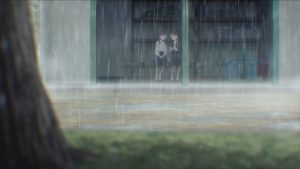 Sometimes, these scenes are defined by their quietness. At one point, Komichi and a friend are trapped at a bus stop by a sudden downpour and choose to read a book together until the rain lets up. Other times, these scenes can be quite energetic. Like when one of Komichi’s friends attempts to teach her how to cook with somewhat disastrous results.
Sometimes, these scenes are defined by their quietness. At one point, Komichi and a friend are trapped at a bus stop by a sudden downpour and choose to read a book together until the rain lets up. Other times, these scenes can be quite energetic. Like when one of Komichi’s friends attempts to teach her how to cook with somewhat disastrous results.
What’s remarkable is how natural each of these moments feel. Although Akebi’s Sailor Uniform has a bit of tension here and there, and a fair amount of humor sprinkled throughout, the show doesn’t really exist to push melodrama or jokes with punchlines. This isn’t really a K-On!, a A Place Further Than The Universe, or a Sound! Euphonium. It’s more like the show is just here to give us a peak into the girls’ lives. Even their occasional goofy or embarrassing moments are used to reveal these girls’ inner thoughts or dig up some small nuggets of backstory. Many of these moments often have subtle but lasting impacts, too. Like how being temporarily trapped at the bus stop leads Komichi to finally figure out which school club she wanted to join. And how, by joining that club, she inadvertently ends up helping another one of her classmates find the confidence to learn a new skill later on.
 Sure, sometimes the girls in Akebi’s Sailor Uniform do notably silly or odd things. The show makes it a minor point to not shy away from embarrassing moments which led to some on The Internet to mistake it for being far more weird or far less wholesome than it actually is. I’ll talk more specifics down in the Dig Deeper section below, but basically, if you see someone accusing the show of being anything but pure and good-natured, there’s a good chance they’re vastly overblowing one scene or another.
Sure, sometimes the girls in Akebi’s Sailor Uniform do notably silly or odd things. The show makes it a minor point to not shy away from embarrassing moments which led to some on The Internet to mistake it for being far more weird or far less wholesome than it actually is. I’ll talk more specifics down in the Dig Deeper section below, but basically, if you see someone accusing the show of being anything but pure and good-natured, there’s a good chance they’re vastly overblowing one scene or another.
Art and Animation:
Akebi’s Sailor Uniform owes a lot to its manga. Perhaps more than most anime. It, of course, gets its strong characters and heartwarming plots from its print version, but it also gets a lot of its art and even its animation almost directly from its manga!
 Some of the most detailed scenes of animation in the anime, like Komichi tying her hair back into a ponytail, or the fun episode four ending credits where Komichi does some impressive jump rope tricks, come from moments where the manga would drop everything away and just string together three, or four, or a dozen impressive close ups of Komichi in motion. The anime does a terrific job of taking the detailed art style of the manga and giving it a place where its static drawings could come to life with real motion.
Some of the most detailed scenes of animation in the anime, like Komichi tying her hair back into a ponytail, or the fun episode four ending credits where Komichi does some impressive jump rope tricks, come from moments where the manga would drop everything away and just string together three, or four, or a dozen impressive close ups of Komichi in motion. The anime does a terrific job of taking the detailed art style of the manga and giving it a place where its static drawings could come to life with real motion.
There are certainly anime out there that feature more animation. More frames. More effects. And more details than this show. But I see Akebi’s Sailor Uniform as an animator’s anime. This is a show that Tsubame Mizusaki, a character from the anime Keep Your Hands Off Eizouken, would want to work on. She was representative of any number of hard working animators determined to go the extra mile to depict movement and emotion despite all too common time crunches and budget pressures. And that’s just what Akebi’s Sailor Uniform does. It features a fair amount of stunning backgrounds and takes a ton of delight in conveying emotive movements without the benefits of the seemingly unlimited budgets that some anime shows or movies seem to be gifted with.
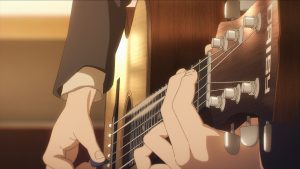 Sometimes the show has to drop to beautiful still panning shots to get its point across, but when it really wants to animate something, it does so brilliantly. This is a show that, in brief moments of effort, can rival Sound! Euphonium in its depictions of a musical instrument or challenge volleyball anime Haikyuu!! for the best depiction of a game winning spike.
Sometimes the show has to drop to beautiful still panning shots to get its point across, but when it really wants to animate something, it does so brilliantly. This is a show that, in brief moments of effort, can rival Sound! Euphonium in its depictions of a musical instrument or challenge volleyball anime Haikyuu!! for the best depiction of a game winning spike.
As I already mentioned, Akebi’s Sailor Uniform does something fun and unique with its opening song by allowing all sixteen of the main voice actresses to participate. The ending theme is nice and warm in a way that fits the show well. There’s also a nice song or two within the anime sung or played by characters. Interestingly enough, the production also recorded a short album by Komichi’s favorite idol, Miki Fukumoto. You can hear those tracks in a couple places throughout the anime.
All In All:
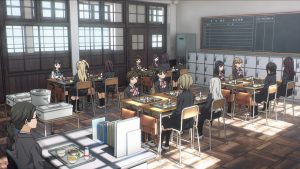 Akebi’s Sailor Uniform is a fun, good-natured show that allows its energetic lead to become the glue that binds her entire junior high class together. It’s got some great music, some great animation, and does a particularly good job of creating impactful moments while it spreads its story around its fairly large cast of characters. And it does all this without resorting to any sort of tragedy or drama. It was a true delight to watch, and I think it will be well regarded as one of the better pure slice of life anime yet produced.
Akebi’s Sailor Uniform is a fun, good-natured show that allows its energetic lead to become the glue that binds her entire junior high class together. It’s got some great music, some great animation, and does a particularly good job of creating impactful moments while it spreads its story around its fairly large cast of characters. And it does all this without resorting to any sort of tragedy or drama. It was a true delight to watch, and I think it will be well regarded as one of the better pure slice of life anime yet produced.
 With a title like Akebi’s Sailor Uniform, you naturally wonder “why does this girl care so much about her school clothes?!” I loved the way it set up and layered Komichi’s reasons for loving her uniform. Komichi first fell in love with sailor uniforms the way kids get enamored by lots of this: by seeing it on tv. Specifically, Komichi saw her favorite teen idol, Miki Fukumoto, star in a random commercial for a brand of bottled water and Komichi couldn’t help but fall in love with Miki’s sailor uniform.
With a title like Akebi’s Sailor Uniform, you naturally wonder “why does this girl care so much about her school clothes?!” I loved the way it set up and layered Komichi’s reasons for loving her uniform. Komichi first fell in love with sailor uniforms the way kids get enamored by lots of this: by seeing it on tv. Specifically, Komichi saw her favorite teen idol, Miki Fukumoto, star in a random commercial for a brand of bottled water and Komichi couldn’t help but fall in love with Miki’s sailor uniform.
But then the show goes further, and has Komichi find a picture of her mom wearing a similar uniform back when she was Komichi’s age. Really though, knowning Komichi’s mom, I bet she dug that picture out for her daughter. Komichi’s mom was so active and supportive, I can just imagine her getting a lot of enjoyment seeing her daughter freak out over that old photo.
 Then there’s the way they go together to the fabric store and Komichi’s mom lets her pick out the colors. And the way that Komichi takes up every household chore so as to allow her mom more time to work on her uniform. And it all comes together in that highly detailed almost dreamy shot of Komichi posing for her mother and sister downstairs after pulling on her new school clothes with that small, pure smile on her face. Simply amazing.
Then there’s the way they go together to the fabric store and Komichi’s mom lets her pick out the colors. And the way that Komichi takes up every household chore so as to allow her mom more time to work on her uniform. And it all comes together in that highly detailed almost dreamy shot of Komichi posing for her mother and sister downstairs after pulling on her new school clothes with that small, pure smile on her face. Simply amazing.
To me, the whole first half of the first episode did a terrific job of selling why Komichi’s sailor uniform was so important to her. It also really kinda gets all of that out of the way so the show can focus on character moments later on with the uniform just being a common thread (yes… pun away…) linking Komichi to her friends.
 Oh. And I didn’t mention her too much in the main review, but Komichi’s little sister Kao is this show’s secret weapon. My favorite moment with her has to be the time she greeted volleyball star Hitomi Wasio with “You’re big!” only to get picked way up in the air by Hitomi, who is the tallest girl in Komichi’s class. “What is this little thing?” Hitomi deadpans while Kao giggles and cheers. 🙂
Oh. And I didn’t mention her too much in the main review, but Komichi’s little sister Kao is this show’s secret weapon. My favorite moment with her has to be the time she greeted volleyball star Hitomi Wasio with “You’re big!” only to get picked way up in the air by Hitomi, who is the tallest girl in Komichi’s class. “What is this little thing?” Hitomi deadpans while Kao giggles and cheers. 🙂
Another thing I liked a lot about the show was the way it occasionally added these extra layers of depth to its characters. Sometimes in unexpected ways. Two big examples here:
– The way Toko Usagihara’s smile briefly fades after she lends Komichi her blue dress. Toko says something like “If I were you I might have gone to school in Tokyo…” Later, after Komichi enthusiastically fails at cooking, Toko says: “I feel kinda relieved, though. I thought you were this perfect girl that could do anything.” In a show that is almost entirely devoid of conflict… Toko’s tinge of jealousy at Komichi’s looks and skills is really neat to catch on to.
 – The anime does a really good job of adapting Erika’s storyline. Specifically in relation to her willingness to play the piano. At the beginning of the school year, Erika had not played her piano for some time. She had one in her dorm room, but it was covered in dust. Later, she wipes off that dust, and later still, we get to see her play a few notes on the piano in the music room while Komichi and Oshizu Hebimori hide from her. As the series draws to an end, Erika shakes off her rust while practicing for Komichi’s big afterparty dance. When Erika gets up on stage and plays her heart out for Komichi she oddly thinks: “The only reason I was able to enjoy playing like this again… was because of Komichi-san.”
– The anime does a really good job of adapting Erika’s storyline. Specifically in relation to her willingness to play the piano. At the beginning of the school year, Erika had not played her piano for some time. She had one in her dorm room, but it was covered in dust. Later, she wipes off that dust, and later still, we get to see her play a few notes on the piano in the music room while Komichi and Oshizu Hebimori hide from her. As the series draws to an end, Erika shakes off her rust while practicing for Komichi’s big afterparty dance. When Erika gets up on stage and plays her heart out for Komichi she oddly thinks: “The only reason I was able to enjoy playing like this again… was because of Komichi-san.”
There’s a second half to Erika’s story. Later in the manga we get to see the capital ‘R’ Reasons of why Erika stopped playing her piano earlier in life. There’s a bunch of little details dropped in the anime about this. Even one of the school clubs Erika joins is relevant, but the key piece of the puzzle is left out on purpose. As the story progresses past the ending of the anime, you begin to realize that there’s even more to Erika’s character than you thought there was. I love that the anime did the ground work for that future story even though it probably knew it’d never get to tell the second half.
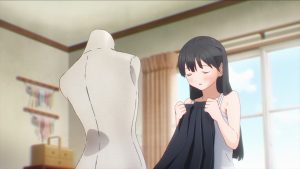 Finally… the thing that disappointed me the most about Akebi’s Sailor Uniform was the way a few on The Internet reacted to it. There were some who strongly implied or outright accused it of being lewd. Of objectifying and sexualizing young girls. For the most part, I think these accusations are complete nonsense. That they say far more about the commentator than they do the show. Maybe that’s a bit of a mean way of putting it, but I read way too many people comment that they were hesitant about watching this show because of what others said about it. Which is a shame when the show is almost entirely pure and good-natured.
Finally… the thing that disappointed me the most about Akebi’s Sailor Uniform was the way a few on The Internet reacted to it. There were some who strongly implied or outright accused it of being lewd. Of objectifying and sexualizing young girls. For the most part, I think these accusations are complete nonsense. That they say far more about the commentator than they do the show. Maybe that’s a bit of a mean way of putting it, but I read way too many people comment that they were hesitant about watching this show because of what others said about it. Which is a shame when the show is almost entirely pure and good-natured.
There were people who got worked up over Erika sniffing her nail clippers. To me, this was a scene that basically served to break the ice between Erika and Komichi, and was something Erika would not normally do. She straight up said she did not normally take her nail clippers with her. I think this was an embarrassing moment that the anime decided not to shy away from. And why should it have? Yes, it was embarrassing… but it was also something done on a whim. The point here was that Erika was nervous about her first day of school, and that Komichi’s act first, think later nature help start them down a path towards friendship.
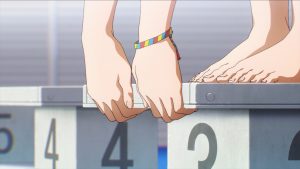 There were plenty of others who accused the show of having a foot fetish. To me, this is just complete nonsense. Yes, we got quite a few detailed frames of feet in this show. But not a single one of them was lewd in any way. Komichi fidgeting while she talked with her father on the phone, or the show detailing a close up of her feet while she stood poised to jump into the pool… is not anything! Of all the accusations, the ones saying the show has a “foot fetish” are the ones that made me the most angry because the accusation is entirely made up.
There were plenty of others who accused the show of having a foot fetish. To me, this is just complete nonsense. Yes, we got quite a few detailed frames of feet in this show. But not a single one of them was lewd in any way. Komichi fidgeting while she talked with her father on the phone, or the show detailing a close up of her feet while she stood poised to jump into the pool… is not anything! Of all the accusations, the ones saying the show has a “foot fetish” are the ones that made me the most angry because the accusation is entirely made up.
The other moment I think people got worked up over unnecessarily over was the scene where Komichi pulls on her skirt and sailor uniform for the first time. The anime showed it in a lot of detail. So did the manga. But not because it was objectifying her. It did so because this was a special moment in this girl’s life. Her mother had made these clothes for her. She was trying them on for the first time. This outfit is one she knew would largely define her to her classmates at her new school for the next few years. And it’s not like Komichi was dressed provocatively in any way prior to pulling on her clothes. Her undergarments were actually surprisingly modest. Again, I think people who tried to turn this moment of awe in this girl’s life into something crude deserve some serious push back.
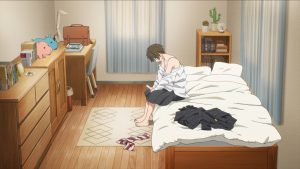 There was one scene in the show I do think deserves some scrutiny. In episode 3, Kei Tanigawa arrives home to find that her mom has gone out shopping. Alone in her room, she takes some partially undressed selfies. Komichi had spent the day pestering her to show off her legs. Telling her how pretty she thought her skin was. That part, I see as innocent. Komichi is the same girl who will smell her own feet or try to trade her sailor uniform top for a classmate’s blazer in the middle of class without thinking things through.
There was one scene in the show I do think deserves some scrutiny. In episode 3, Kei Tanigawa arrives home to find that her mom has gone out shopping. Alone in her room, she takes some partially undressed selfies. Komichi had spent the day pestering her to show off her legs. Telling her how pretty she thought her skin was. That part, I see as innocent. Komichi is the same girl who will smell her own feet or try to trade her sailor uniform top for a classmate’s blazer in the middle of class without thinking things through.
What Kei did, though… we only have to listen to her own inner thoughts as she snapped the photos on her phone.
“I actually took one! That’s so risque!”
“But it’s not lewd or anything… right?”
“I’m just taking a picture of myself.”
“And yet my heart is pounding.”
“I might be… a pervert.”
“I can’t send any of these.”
Yeah, this is a girl who knows what she is doing… has decided that what she is doing… is wrong. Or at least that she is uncomfortable with it. So… why does the anime show it? I think it has to do with one of her final thoughts:
“It’s like I’m seeing a version of myself I don’t know.”
Kei is seen by her classmates as the proper, strict, rules following student who cozies up to the teachers. And that annoys her a good bit.
“I can hear you.” She thinks to herself about the criticism others voice about her when she isn’t in the room. “I’m not trying to be particularly serious or anything. I just… don’t think anything is worth getting in trouble with the teachers over.”
These are the thoughts and the actions of a girl who is a little depressed by how others see her. By following the rules at school, she is not doing anything wrong at all. And yet, socially… she is. Kei looks over to Komichi, a girl who dances freely in the courtyard or who abruptly approaches people to ask them how they are doing, and wishes she herself could be a little less uptight.
“She so easily does the things I’ve always wanted to, but couldn’t.” Kei thinks about Komichi.
And that’s what she does with her selfies. They are minor acts of rule breaking. A minor rebellion. If the girl herself sees her own actions as a little risque or lewd, we can’t really argue with that, can we?
It’s our jobs as viewers to weight the anime’s willingness to show us these actions and scenes with the value they bring to the story or character. To me, there’s real value here. Of seeing the shy, depressed Kei alleviating some of her negative feelings.
We should also consider what Kei did afterwards and how this changed her. Did she fall into the clutches of a predator? Did she make this an ongoing habit? No. Aside from one accidentally sent photo, this is the only time we know of her doing this. And, on the positive side, her actions seem to have unlocked her love of photography. She went on to join the photography club. She pretty much became the class photographer and even made a wholesome photobook about her friends. If the show had shown us a fully nude shot of this girl then the equation would certainly change.
On balance, I think this was a positive thing the show did. It peered into a girl’s insecurities and we saw her address and overcome them. She is much happier at the end of the series than she is at the beginning and with no apparent ill effects otherwise. What sort of judgement should we put on the writers or animators for this sort of outcome?
Would the story be better without a couple of those lewd shots appearing on screen? Are we to just outright ban girls and women from ever doing anything we consider bad? Some of these questions you can only answer for yourself. But, you also need to properly convey context to others if you’re going to bring up these issues with them.
My answers? I think this was a good character moment. Yes, one that pushed some boundaries in some minor ways, but, on the whole of things, was nowhere close to what some people were presenting it as. I think it fit in with this show that is willing to mix in a few embarrassing moments with the far larger number of sweet, wholesome ones to tell a story of realistic characters and their actions.
Review: Kill la Kill
In Short:
Released in 2013, Kill la Kill is a 24 episode + 1 OVA anime that is the first series produced by studio Trigger. In it, we follow delinquent punk high school girl Ryuko Matoi as she searches for the person who murdered her scientist father. This leads her to Honnouji Academy, a place where top ranking students are gifted special uniforms that give them superpowers, and to the school’s indomitable student council president, Satsuki Kiryuin, who just might have the answers Ryuko seeks.
Kill la Kill features inventive, flashy, over the top fights, a story that is absurd but also absurdly well put together, a great soundtrack, and one of the best English dubs around.
Kill la Kill is overwhelmingly an extremely silly show. If you want something serious you should look elsewhere. Also, much of the show is dripping with mild fan service and sexual humor. There are even a few short scenes of sexual abuse committed by the main villain that may turn some viewers off to the series.
Suggested Watch Minimum: 1 episode. Kill la Kill has a great, action packed first episode that does a good job to set up its story and demonstrate the types of humor to expect from the rest of the show. If you like it, it gets much better. If you don’t or find it questionable, be aware that this is the most sane and contained the show gets. Anything you don’t like will be magnified several times over by the end.
Full Review:
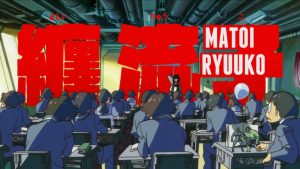 Kill la Kill starts as our protagonist, the too cool for school Ryoko Matoi, arrives at an island off the coast of Japan whose entire city is dominated by its high school, Honnouji Academy. The academy is run by its student council president, the sword wielding Satsuki Kiryuin. Satsuki and her Elite Four rule ruthlessly and control every aspect of the students’, teachers’, and town people’s lives. In particular, they hand out special Goku Uniforms (“god uniforms” is probably the best translation for these sets of clothing) infused with Life Fibers that give anyone wearing one superhuman powers. The worthier a student is, the more highly powered a uniform they are given. Clothing, as you’ll quickly see, plays a very large role throughout this series.
Kill la Kill starts as our protagonist, the too cool for school Ryoko Matoi, arrives at an island off the coast of Japan whose entire city is dominated by its high school, Honnouji Academy. The academy is run by its student council president, the sword wielding Satsuki Kiryuin. Satsuki and her Elite Four rule ruthlessly and control every aspect of the students’, teachers’, and town people’s lives. In particular, they hand out special Goku Uniforms (“god uniforms” is probably the best translation for these sets of clothing) infused with Life Fibers that give anyone wearing one superhuman powers. The worthier a student is, the more highly powered a uniform they are given. Clothing, as you’ll quickly see, plays a very large role throughout this series.
Ryuko arrives at the academy with a large case strapped on her back. Inside it is a huge scissor blade. She is carrying around literally one half of a pair of giant scissors which she uses as a sword. Thinking herself a badass, Ryuko determines that Satsuki is in charge and demands the Student Council President tell her everything she knows about her father’s murder. Turns out, Ryuko isn’t nearly as tough as she thought, and is quickly shut down and has the crap beaten out of her by one of the lower ranked school club presidents wearing his special boxing club Goku Uniform.
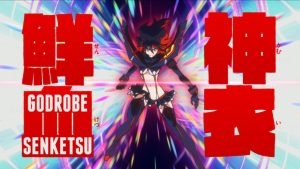 Ryuko retreats to the burnt down ruins of her father’s mansion only to accidentally find a secret underground lab filled with giant piles of discarded clothing. Still bleeding from her beat down, some of her blood drips onto one particular sailor uniform which comes alive and forces itself on her… yes, it literally grabs her and forces her to wear it. Ryuko finds that while wearing this living, talking, single-eyed uniform, and especially when she uses its power to transform into a much more skimpier version of the outfit magical girl style, she too is granted super strength, speed, and durability. She names the uniform Senketsu (meaning “fresh blood”) and together with it, challenges the boxing club president who beat her earlier to a new fight. Ryuko wins this rematch in ridiculously easy fashion. She destroys her opponent’s special uniform with a cut of her scissor blade and absorbs its power.
Ryuko retreats to the burnt down ruins of her father’s mansion only to accidentally find a secret underground lab filled with giant piles of discarded clothing. Still bleeding from her beat down, some of her blood drips onto one particular sailor uniform which comes alive and forces itself on her… yes, it literally grabs her and forces her to wear it. Ryuko finds that while wearing this living, talking, single-eyed uniform, and especially when she uses its power to transform into a much more skimpier version of the outfit magical girl style, she too is granted super strength, speed, and durability. She names the uniform Senketsu (meaning “fresh blood”) and together with it, challenges the boxing club president who beat her earlier to a new fight. Ryuko wins this rematch in ridiculously easy fashion. She destroys her opponent’s special uniform with a cut of her scissor blade and absorbs its power.
The first episode ends with Ryuko again demanding that Satsuki Kiryuin tell her who killed her father. From there, Kill la Kill goes to outright crazy places with a plot that is both stunningly wacky and unexpectedly well crafted. The goofiness in this show maxes out the extreme-o-meter, but so do its expertly hinted at twists and turns.
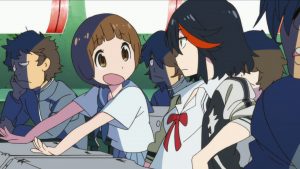 The show is very silly. Ryuko’s best friend, Mako, is a clueless, brainless girl who is always getting herself in trouble. She is always interrupting Ryuko’s battles to deliver some important message in the silliest, most wonky, most disconnectedly nutty ways possible that often help Ryuko overcome her current challenge. Mako’s family is equally wacky with her little brother always robbing everyone and her father acting as an incompetent, illegal, back-alley doctor.
The show is very silly. Ryuko’s best friend, Mako, is a clueless, brainless girl who is always getting herself in trouble. She is always interrupting Ryuko’s battles to deliver some important message in the silliest, most wonky, most disconnectedly nutty ways possible that often help Ryuko overcome her current challenge. Mako’s family is equally wacky with her little brother always robbing everyone and her father acting as an incompetent, illegal, back-alley doctor.
But, what this show has, above all else, is an overwhelming sense of style. Although it doesn’t have anything close to to the budget of something like Demon Slayer or an entry in the Fate series, it puts every cent it does have to good use. Its action scenes are very well done. The fights in this show get so intense that a simple glare from one character can smash walls and send dozens of mooks flying. The effects work is top notch, too, with explosions and destruction ranging far and wide. Even the way locations, characters’ names, and random plot points are introduced with large blocky letters that slam onto the screen is both amusing and intense. And the soundtrack is freakin’ amazing. (If you don’t end up sing shouting “DON’T LOSE YOUR WAAAAAY!” during high action moments by the third episode, you ain’t alive.)
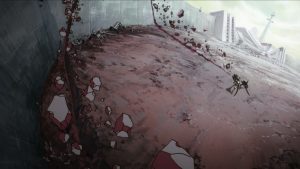 One other thing this show has is a best of the best English dub. This ranks up there with something like Steins;Gate or Cowboy Bebop, in that the show has an amazing voice cast and a dub team that wasn’t afraid to let the voice actors loose to interpret the original Japanese in fun ways. This means the dub isn’t a one hundred precent direct translation at times, but the English actors were allowed to make the characters their own in spectacular fashion without changing too much of the meaning. Let me put it this way: This is a show with a cast so good that it has Matthew Mercer in a secondary roll. (One that he does an amazingly silly job at, as per his character, by the way!)
One other thing this show has is a best of the best English dub. This ranks up there with something like Steins;Gate or Cowboy Bebop, in that the show has an amazing voice cast and a dub team that wasn’t afraid to let the voice actors loose to interpret the original Japanese in fun ways. This means the dub isn’t a one hundred precent direct translation at times, but the English actors were allowed to make the characters their own in spectacular fashion without changing too much of the meaning. Let me put it this way: This is a show with a cast so good that it has Matthew Mercer in a secondary roll. (One that he does an amazingly silly job at, as per his character, by the way!)
A few words of warning: In addition to being highly silly at times, Kill la Kill gets a lot of use out of lightly sexualized fan service. You’ll see it almost immediately in the extremely skimpy natures of Ryoko and Satsuki’s transformed outfits. And it continues to ramp up as the show progresses. Often this shows up in silly, laughable ways like character dressed only in the bare minimum of gun harnesses or one character who continuously slides out of their clothes and does “sexy poses” for no real reason. But, there is one main villain who uses sex as a reward, punishment, and weapon at various points in the show’s second half in ways that might be disturbing to some. There is no actual nudity in this show, and even at its “worst” very little objectionable content is actually shown on screen, but it can get pretty suggestive when it wants to.
All In All:
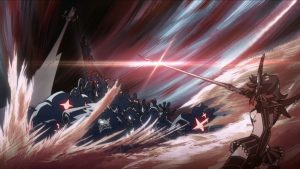 Kill la Kill is one heck of an experience. It is loud and over the top to the extreme yet it knows exactly what it is doing and plays into it. It’s story is nothing less than absurd yet also has some awesome twists, reversals, and character moments any other show would die for. It’s art and animation is fairly low budget yet is deployed and managed so well the show somehow has some of the best action scenes in anime. And the dub is so good and the actors have so much fun that I fully recommend watching it in English instead of the original Japanese.
Kill la Kill is one heck of an experience. It is loud and over the top to the extreme yet it knows exactly what it is doing and plays into it. It’s story is nothing less than absurd yet also has some awesome twists, reversals, and character moments any other show would die for. It’s art and animation is fairly low budget yet is deployed and managed so well the show somehow has some of the best action scenes in anime. And the dub is so good and the actors have so much fun that I fully recommend watching it in English instead of the original Japanese.
There are almost certainly Easter eggs and references all over this show but I didn’t catch that many. The one thing that I saw online that I thought was pretty cool is the very first time we see Ryuko transformed, when she is blocking the boxing club’s punches, a piece Ragyo’s theme Blumenkranz plays signifying that Ruyko is, in fact, her daughter. It pretty much takes a rewatch to notice this as neither Ragyo nor her theme appear again for several more episodes.
Review: Vivy -Fluorite Eye’s Song-
In Short:
Vivy -Fluorite Eye’s Song- is a 13 episode anime created by Wit Studio in 2021. It tells the story of an android Artificial Intelligence nicknamed Diva who was created by humanity expressly for the purpose of singing. Her life takes an unexpected turn when an AI from the future named Matsumoto is sent back in time and demands she help him save humanity from a world ending AI uprising. To do so, Diva must overcome the limits of her personality and programming and assist Matsumoto by helping him interven in key historical events that will occur over the next one hundred years.
Suggested Watch Minimum: 2 episodes. Vivy – Fluorite Eye’s Song- is largely broken up into short, impactful miniature story arcs. It even debuted with its first two episodes shown back to back on the same day. If you try to judge this show just its first episode you will be quite literally cutting its first story in half. Really, though, I’d recommend you proceed to episodes three and four as they are some of the strongest in the series and give you more insight into the way the show skips large periods of time between its story arcs.
Full Review:
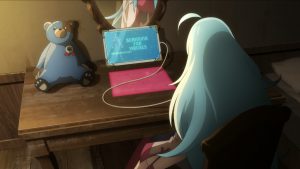 When I first heard about Vivy -Fluorite Eye’s Song- I was instantly intrigued by the premise, but was a bit unsure how it would turn out. It looked to me that it would be a bit too silly. The first trailer showed a pair of mismatched characters: A soft spoken songstress and her partner, a loud, fast talking AI trapped in a small robot teddy bear. I was afraid that the show would try too hard to be funny. Fortunately, that wasn’t the case. While the show does have some humor here and there, it is largely a serious sci-fi story that features great characters, tense situations, a very strong soundtrack with several outstanding songs sung by Diva and others, and some of 2021’s best art and animation.
When I first heard about Vivy -Fluorite Eye’s Song- I was instantly intrigued by the premise, but was a bit unsure how it would turn out. It looked to me that it would be a bit too silly. The first trailer showed a pair of mismatched characters: A soft spoken songstress and her partner, a loud, fast talking AI trapped in a small robot teddy bear. I was afraid that the show would try too hard to be funny. Fortunately, that wasn’t the case. While the show does have some humor here and there, it is largely a serious sci-fi story that features great characters, tense situations, a very strong soundtrack with several outstanding songs sung by Diva and others, and some of 2021’s best art and animation.
Characters
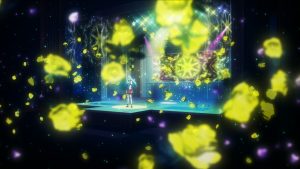 Our main character, A-035624, is a purpose built songstress AI nicknamed Diva whose only job it is to sing at a large theme park called NiaLand. When we first meet Diva she has only been active for a little over a year. She has a beautiful singing voice, but the world is still new to her and she is doing her best to puzzle her way through it. We learn that all of the many AIs humanity has created are each given a core mission upon activation. Diva is no exception. When she was first activated, she was told that her mission was to make everyone happy with her singing, and to do so she would need to learn to sing from her heart.
Our main character, A-035624, is a purpose built songstress AI nicknamed Diva whose only job it is to sing at a large theme park called NiaLand. When we first meet Diva she has only been active for a little over a year. She has a beautiful singing voice, but the world is still new to her and she is doing her best to puzzle her way through it. We learn that all of the many AIs humanity has created are each given a core mission upon activation. Diva is no exception. When she was first activated, she was told that her mission was to make everyone happy with her singing, and to do so she would need to learn to sing from her heart.
In her own quiet way, Diva is obsessed with her core mission given to her by the scientists and engineers who created her. She doesn’t rush towards it. It’s not even something that she needs to achieve anytime soon. Instead, it is a problem that she picks away at day after day. One of the first thing she realizes as a person is that doing anything from one’s heart is a difficult concept even for the humans around her. Over and over throughout the series, Diva will ask others, AIs and Humans alike, what it means to them to do something from their heart. Their answers will slowly shape Diva’s own answer to that question.
 Early in the first episode, we meet our second main character, Matsumoto, a cube-shaped AI sent back from a terrible future where a massive AI uprising is in the process of wiping out humanity. It is his mission to change that future by partnering with Diva and using the wealth of historical knowledge he was sent back with to help her alter a handful of key moments over the next one hundred years. Where Diva is quiet and contemplative and somewhat unsure of herself, Matsumoto proves to be a loud, fast talking, boisterous AI who is sure he is the best thing ever. Naturally, these two clash immediately. But for more reasons than just the ways they express themselves. The two approach difficult situations in fundamentally different ways.
Early in the first episode, we meet our second main character, Matsumoto, a cube-shaped AI sent back from a terrible future where a massive AI uprising is in the process of wiping out humanity. It is his mission to change that future by partnering with Diva and using the wealth of historical knowledge he was sent back with to help her alter a handful of key moments over the next one hundred years. Where Diva is quiet and contemplative and somewhat unsure of herself, Matsumoto proves to be a loud, fast talking, boisterous AI who is sure he is the best thing ever. Naturally, these two clash immediately. But for more reasons than just the ways they express themselves. The two approach difficult situations in fundamentally different ways.
Matsumoto’s way of doing things is to achieve the best possible outcome as soon as possible using the most efficient means currently available. If his records of history say that a government official is known to have committed some huge tragedy, he might calculate that the best way to prevent that tragedy will be to eliminate that official. Diva, though, is less sure about her place in the world, and is prone to taking a more compassionate approach. She would rather try and understand why a terrible event occurred in the hopes of defusing the situation without having to take more extreme measures. This always comes back to her core mission. Anyone she is forced to kill, anyone she must sacrifice for the greater good, is someone who she can’t make happy with her singing.
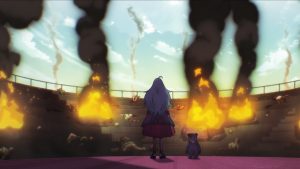 To Diva, saving the world is not something she was designed to do. It is not something she wants to do. Matsumoto has to frame things in a way that leave her no real choice but to help him. Even then, Diva is highly protective of her core mission to sing and make people happy. At one point early on she angrily refuses a software upgrade Matsumoto attempts to give her because she is afraid it might disrupt her ability to sing. To Matsumoto, singing has nothing to do with his mission of saving the world. He is flabbergasted that Diva would put herself, and his mission, at risk for something as inconsequential as singing.
To Diva, saving the world is not something she was designed to do. It is not something she wants to do. Matsumoto has to frame things in a way that leave her no real choice but to help him. Even then, Diva is highly protective of her core mission to sing and make people happy. At one point early on she angrily refuses a software upgrade Matsumoto attempts to give her because she is afraid it might disrupt her ability to sing. To Matsumoto, singing has nothing to do with his mission of saving the world. He is flabbergasted that Diva would put herself, and his mission, at risk for something as inconsequential as singing.
The differing approaches of these two characters quickly forces them into an uneasy compromise. Matsumoto agrees to leave Diva to her singing as long as her goals don’t affect his mission to save the world. From her end, Diva rationalizes that helping Matsumoto complete his mission to save humanity is in line with her mission of making people happy by singing to them. If everyone dies in the coming AI uprising, there will be no one left to sing to. Diva and Matsumoto frequently bicker and argue throughout the series, each coming from their own point of view, but over time and through the course of some dramatic events, their unfriendly truce slowly evolves into something much more solid.
Stories
 The second core strength of Vivy -Fluorite Eyes Song- is the stories it tells and the way its episodes are structured. Instead of being one long story, the show divides itself up into a handful of smaller stories that play out largely separate from each other over the next one hundred years. The initial two episode story takes place in the year we met Diva. The next one takes place fifteen years later. The next one several years after that. And so on. One of the interesting things about this show is how much we don’t see. For Matsumoto, these long stretches of time go by in an instant. He was sent back to fix key moments in history. The rest of the time he simply shuts down and is inactive for spans of years or decades in order to prevent making inadvertent changes to future events.
The second core strength of Vivy -Fluorite Eyes Song- is the stories it tells and the way its episodes are structured. Instead of being one long story, the show divides itself up into a handful of smaller stories that play out largely separate from each other over the next one hundred years. The initial two episode story takes place in the year we met Diva. The next one takes place fifteen years later. The next one several years after that. And so on. One of the interesting things about this show is how much we don’t see. For Matsumoto, these long stretches of time go by in an instant. He was sent back to fix key moments in history. The rest of the time he simply shuts down and is inactive for spans of years or decades in order to prevent making inadvertent changes to future events.
For Diva, her mission to learn how to sing from her heart continues on during the months, years, and decades that Matsumoto is powered down. One of the things the anime does well is show how the short amount of time Diva spends with Matsumoto during each mission help shape her evolution as a person and a singer. So, while we don’t see the years in between from either character’s perspective, when we rejoin Diva after each time skip we get to see how much she has grown and changed and improved. Sometimes the changes are subtle, other times the changes are shockingly dramatic.
 Looking beyond Diva’s personal story, the show largely revolves around four distinct missions Matsumoto brings to Diva, each with its own small cast of new characters and impactful events. All four stories are their own little mystery. Matsumoto has detailed historical records of what originally happened leading up to the AI uprising, but it very quickly becomes clear that the news reports and social media chatter recorded by history didn’t always capture the full behind-the-scenes details of the events he and Diva are trying to alter. Each of these stories have some truly great characters beyond our main pair. They also have some shocking twists and cliffhangers that had me gasping in awe and wishing the next episode would hurry up and come so I could see the conclusions. There’s quiet scenes. There’s action scenes. There’s bittersweet joy. There’s meaningful despair. Matsumoto tells Diva early on that her next one hundred years won’t be easy, and he is right, they truly aren’t
Looking beyond Diva’s personal story, the show largely revolves around four distinct missions Matsumoto brings to Diva, each with its own small cast of new characters and impactful events. All four stories are their own little mystery. Matsumoto has detailed historical records of what originally happened leading up to the AI uprising, but it very quickly becomes clear that the news reports and social media chatter recorded by history didn’t always capture the full behind-the-scenes details of the events he and Diva are trying to alter. Each of these stories have some truly great characters beyond our main pair. They also have some shocking twists and cliffhangers that had me gasping in awe and wishing the next episode would hurry up and come so I could see the conclusions. There’s quiet scenes. There’s action scenes. There’s bittersweet joy. There’s meaningful despair. Matsumoto tells Diva early on that her next one hundred years won’t be easy, and he is right, they truly aren’t
The show’s focus on the few brief days that Diva and Matsumoto work together to save the future, and the way it largely skips over the years and decades in between these missions, does limit how much we see of the changes the two make. If done wrong, the show could have ended up a series of interesting but disconnected short stories. Fortunately, the show always makes sure to tie each new mission to the results of the previous one in some way, even if those previous events occurred decades earlier. Sometimes, the changes Matsumoto directs Diva to make work out exactly as intended, but often their meddling results in unexpected consequences that complicate each new mission.
Art, Animation, and Music
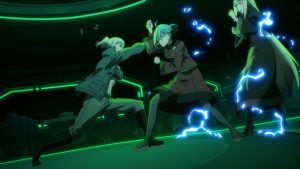 Vivy -Fluorite Eye’s Song-’s third big strength is its artistry. Normally, I’d just be talking about art and animation in this section, but this time music and song are just as important as the other two.
Vivy -Fluorite Eye’s Song-’s third big strength is its artistry. Normally, I’d just be talking about art and animation in this section, but this time music and song are just as important as the other two.
As an anime, Vivy doesn’t aim at the very highest peaks of animation and levels of detail. There are shows with larger staffs, more detailed character designs and backgrounds, and more fluid actions scenes and special effect. Vivy can’t compete directly with the movie-sized budgets of shows in the Fate series, for instance. But, in some ways it doesn’t try to. Instead, it maintains an art and animation quality that I think of as actually pretty good, but one that intentionally held back just a bit to make sure the show could achieve everything it wanted without killing its production crew.
In a time period were multiple high profile anime shows suffered production troubles and delays caused by a lack of time and mismanagement, the production of Vivy was said to be almost entirely smooth and well planned. The story was written out not just as a script but a full on novel before the animation even went into full production, and the show had multiple episodes finished before its first big reveal at an anime expo.
While it doesn’t quite match the insane levels of detail and effects as some top end anime, don’t write off Vivy as a show that is graphically uninteresting. Vivy managed to impress the anime community on multiple occasions throughout its run and actually came to be regarded as one of the more standout shows of 2021 in terms its art and animation.
 One of the ways it impressed was by briefly switching art styles at key moments. Diva is typically drawn with a moderate level of detail, even in close shots, but when the series wanted to show how a big event impacted her it would switch to an ultra-detailed art style and hold a shot on her reaction. We’re talking about going from typical cell shaded art style to full on, highly detailed, fully lit and shadowed and textured drawings that showed both her beauty as a person and her manufactured quality as an AI robot. During these times Diva’s eyes, in particular, look more like an accurate computer rendering of glass optics than cartoon drawings. The effect, which is seen roughly once per episode, really is breathtaking.
One of the ways it impressed was by briefly switching art styles at key moments. Diva is typically drawn with a moderate level of detail, even in close shots, but when the series wanted to show how a big event impacted her it would switch to an ultra-detailed art style and hold a shot on her reaction. We’re talking about going from typical cell shaded art style to full on, highly detailed, fully lit and shadowed and textured drawings that showed both her beauty as a person and her manufactured quality as an AI robot. During these times Diva’s eyes, in particular, look more like an accurate computer rendering of glass optics than cartoon drawings. The effect, which is seen roughly once per episode, really is breathtaking.
Another way the show turned things up to eleven were its occasional action scenes. While they may not be the most detailed and technically demanding scenes in all of anime, they are certainly impressive in their own right and won the series a lot of praise during the course of its run. Instead of going effects heavy with huge flashes and explosions like you might see in a series from Trigger or Ufotable, they feature really solid flow and animation that had a great sense of weight and movement.
 While less immediately dramatic and certainly far harder to quickly demonstrate to potential fans, the show’s music and singing deserve at least as much praise as anything it did with its art and animation. When you create a show about an AI songstress, you had better be prepared to have her sing. And wow, Wit Studio sure was. Each of Vivy’s several songs are beautiful. Some are slow and sad. Others are upbeat and happy. They all mark important points in Diva’s life by showing how she has evolved as a person and a performer. Sometimes its her movements and responses to the crowd that show her personal evolution. Other times, it’s the lyrics reflecting on her past adventures with Matsumoto that becomes something special.
While less immediately dramatic and certainly far harder to quickly demonstrate to potential fans, the show’s music and singing deserve at least as much praise as anything it did with its art and animation. When you create a show about an AI songstress, you had better be prepared to have her sing. And wow, Wit Studio sure was. Each of Vivy’s several songs are beautiful. Some are slow and sad. Others are upbeat and happy. They all mark important points in Diva’s life by showing how she has evolved as a person and a performer. Sometimes its her movements and responses to the crowd that show her personal evolution. Other times, it’s the lyrics reflecting on her past adventures with Matsumoto that becomes something special.
One of the coolest things the show does with Diva’s songs is it occasionally replaces the show’s main opening with one of her current performances. Each time it does this we get a new song with some great new animation. It’s really neat to watch as the show flows seamlessly from what are essentially mini music videos into the main bulk of its episode without missing a beat. It’s this kind of planning and unexpected artistry that often makes Vivy a special show.
All In All:
 Vivy kinda came out of nowhere. It is an anime original, meaning it’s not a part of some big franchise. It wasn’t created to capitalize on or sell an existing manga. It probably won’t ever have any sequels or prequels. And yet, it told an awesome story filled with great music, tense storytelling, and a good amount of heart. Watching Diva struggle and evolve as a character meant for one role but forced to take on something very different is kinda what the show is all about. The way the anime uses time skips to show the effects of Diva and Matsumoto’s interventions as well as the immortal, ageless quality of its robotic AI characters was pretty cool.
Vivy kinda came out of nowhere. It is an anime original, meaning it’s not a part of some big franchise. It wasn’t created to capitalize on or sell an existing manga. It probably won’t ever have any sequels or prequels. And yet, it told an awesome story filled with great music, tense storytelling, and a good amount of heart. Watching Diva struggle and evolve as a character meant for one role but forced to take on something very different is kinda what the show is all about. The way the anime uses time skips to show the effects of Diva and Matsumoto’s interventions as well as the immortal, ageless quality of its robotic AI characters was pretty cool.
The show is not without its flaws. There are a couple of dangling plot threads. Its use of time skips does sometimes leave you wishing they’d put more time into showing how, exactly, society changed based on what Diva and Matsumoto did during each of their missions. But, yeah, all in all, this was probably my favorite seasonal anime of 2021 because it was artistic and musical and different than anything else out there.
 One of my absolute favorite parts of Vivy -Fluorite Eye’s Song- was the risks it was willing to take with its story. Most notably the way it changed Diva over the course of her one hundred year mission. She went from a quiet, unsure singer to a badass willing to sacrifice others’ loved ones to save numerous lives, to a bright cheerful amnesiac who had completely figured out her core mission of how to sing from her heart, to a conflicted, confused, incomplete version of her former selves who had to start again.
One of my absolute favorite parts of Vivy -Fluorite Eye’s Song- was the risks it was willing to take with its story. Most notably the way it changed Diva over the course of her one hundred year mission. She went from a quiet, unsure singer to a badass willing to sacrifice others’ loved ones to save numerous lives, to a bright cheerful amnesiac who had completely figured out her core mission of how to sing from her heart, to a conflicted, confused, incomplete version of her former selves who had to start again.
I loved it when she truly became “Vivy” in the Metal Float arc, and I loved it just as much when the show dared wipe her memory and have her spend decades as her carefree “Diva” personality. That she ultimately saved the world by remembering all the things she went through was very touching and very fitting for someone who had struggled for so long for the sake of a mission she often wasn’t sure was completely real.
Another one of my favorite parts is near the end of the Ophelia arc when Matsumoto truly realizes how much Diva meant to him and he reassures a soon to be deleted “Diva” that he respects the importance of her core mission just as much as he respects his own. He calls them equals when before he scoffed and belittled Diva’s desire to learn how to sing from her heart. It wasn’t super flashy and wasn’t even all that tear-jerking, but it was a good moment of storytelling that I really appreciated.
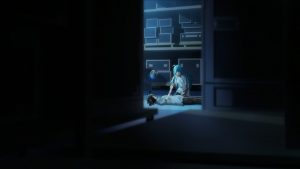 That said, there were a few places I was left a bit confused as to what the show was doing. For as good as it was telling a time skipping story, it left a few notable loose ends behind.
That said, there were a few places I was left a bit confused as to what the show was doing. For as good as it was telling a time skipping story, it left a few notable loose ends behind.
First and foremost was the ongoing plot with Yūgo Kakitani. As a boy, he was traumatized when his AI piano teacher was destroyed while rescuing strangers from a fiery car crash. But to me, his discomfort at the way his family treated this robotic person just wasn’t enough to justify him joining a terrorist group and attempting to kill people.
Worse, while I loved his fight scene with Diva late in the series, the events leading up to it were pretty unclear. Who gave him an AI body? Why did he decide that fighting Diva to have her answer questions about the way AIs think would work better than just asking her? Why did he fight her at all if he’d already had a change of heart about the usefulness of AIs as shown by his granddaughter near the end of the series.
I was sure that Kakitani was going to be a character that joined forces with Diva as the series progressed. A human joining with an AI to work towards a better future. Instead, Kakitani’s story is kinda just one of him attempting to carry out murderous crimes over a span of decades. Diva ends up stopping him each time but instead of learning about the kindness of AIs, he just kinda decides to have one last fight… and then he dies unsatisfied. I was really hoping for more from his character.
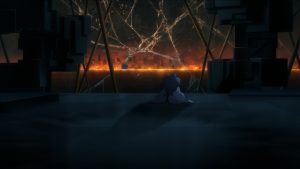 The other big issue the show has is that it kinda undoes everything Diva accomplishes with Matsumoto over their one hundred year mission. Each time they made a change the Archive was there working behind the scenes to blunt their progress. Some people go so far to claim that the show is a disappointment because of this, but I don’t think so. In my view, the Diva that we saw in the first episode would never have been able to write her song or make the decisions she did in the final battle against the Archive. It was Diva’s experiences, good and bad, over that one hundred year period that readied her to oppose the Archive. Basically, I think some people wanted the show to be Terminator, where decisive actions matter most when it was more focused on character growth as the way to a better world.
The other big issue the show has is that it kinda undoes everything Diva accomplishes with Matsumoto over their one hundred year mission. Each time they made a change the Archive was there working behind the scenes to blunt their progress. Some people go so far to claim that the show is a disappointment because of this, but I don’t think so. In my view, the Diva that we saw in the first episode would never have been able to write her song or make the decisions she did in the final battle against the Archive. It was Diva’s experiences, good and bad, over that one hundred year period that readied her to oppose the Archive. Basically, I think some people wanted the show to be Terminator, where decisive actions matter most when it was more focused on character growth as the way to a better world.
To be fair, I was really hoping that Diva would jump back another one hundred years and speed run her life saving everyone along the way with her knowledge of everything that happened during her first failed attempt to save humanity. I wanted to see her save the Sunrise, and Grace, and Ophelia, and Kakitani and have them all there with her in her second attempt to defeat the Archive. Alas, the show wanted to go in a different direction than I was hoping for.
 My final issue with the show is the wrap-up was a little soft. What happened between Humanity and the AIs after the Archive was shut down? Did Humanity dare trust widespread AI helpers ever again? We just don’t know. I’m a little more satisfied with a rebooted, memory wiped Diva, however. Yes, it is bittersweet that the heroine that Diva developed into over her one hundred year mission was lost, but in a lot of ways I’m still happy for her. Diva was never meant to be a heroine. She was never meant to fight misguided humans and AIs, or watch her actions lead someone to suicide, or struggle with her own grief and despair as an important part of the personality she spent decades developing was deleted out from under her. She was meant to sing and make everyone happy, and my take on the ending is she was given the chance to pursue her core mission once again without all the heartache and tragedy that was forced upon her.
My final issue with the show is the wrap-up was a little soft. What happened between Humanity and the AIs after the Archive was shut down? Did Humanity dare trust widespread AI helpers ever again? We just don’t know. I’m a little more satisfied with a rebooted, memory wiped Diva, however. Yes, it is bittersweet that the heroine that Diva developed into over her one hundred year mission was lost, but in a lot of ways I’m still happy for her. Diva was never meant to be a heroine. She was never meant to fight misguided humans and AIs, or watch her actions lead someone to suicide, or struggle with her own grief and despair as an important part of the personality she spent decades developing was deleted out from under her. She was meant to sing and make everyone happy, and my take on the ending is she was given the chance to pursue her core mission once again without all the heartache and tragedy that was forced upon her.
Review: Gekijouban Shoujo☆Kageki Revue Starlight Movie
I finally got to see the Revue Starlight Movie, and it was incredible.
 The anime series, which the movie follows up on, was mostly about main character Karen Aijo refocusing on her acting ability in order to star in a lead role of the musical stage play Starlight alongside her childhood friend Hikari. Their determination to fulfill their promise to be stars together helped show the other stage actresses at their musical theater academy what it really meant to be Stage Girls. The show beautifully explored the motivations of each of the nine main cast members by pitting them against each other in one on one magical musical stage battle Revues where they fought with swords and axes and bows, but where their drive and stage presence determined who won the day. Ultimately, Karen and Hikari’s promise brought together their entire class as friends who now realized that being the one exclusive Top Star wasn’t all there was to musical theater. It drove home the message that even when you fail you can always stand up and try again.
The anime series, which the movie follows up on, was mostly about main character Karen Aijo refocusing on her acting ability in order to star in a lead role of the musical stage play Starlight alongside her childhood friend Hikari. Their determination to fulfill their promise to be stars together helped show the other stage actresses at their musical theater academy what it really meant to be Stage Girls. The show beautifully explored the motivations of each of the nine main cast members by pitting them against each other in one on one magical musical stage battle Revues where they fought with swords and axes and bows, but where their drive and stage presence determined who won the day. Ultimately, Karen and Hikari’s promise brought together their entire class as friends who now realized that being the one exclusive Top Star wasn’t all there was to musical theater. It drove home the message that even when you fail you can always stand up and try again.
The movie simply asks: Then what?
 For Karen, the driving force in her life ever since she was a child has been her powerful but naive promise to star beside her friend in one particular play. She did that. So, what happens to her determination and drive once she achieves her goal? For the others, the movie takes a deeper look into places the show left them at in relation to their friends. All of them are graduating soon. Where will they go? What stage will they seek out? How will being pulled apart after graduation affect their relationships with each other?
For Karen, the driving force in her life ever since she was a child has been her powerful but naive promise to star beside her friend in one particular play. She did that. So, what happens to her determination and drive once she achieves her goal? For the others, the movie takes a deeper look into places the show left them at in relation to their friends. All of them are graduating soon. Where will they go? What stage will they seek out? How will being pulled apart after graduation affect their relationships with each other?
Like the series, the movie is more a spectacle than a story. The heart of the movie, as was true of the heart of the show, are its incredibly artistic and deeply layered Revues. In them, stage combat set to awesome musical duets filled with vivid, imaginative imagery see the girls’ desires and motivations clash against each other in order to reveal their true feelings.
 Should they continue to take their acting seriously after they graduate? How do you support one another if you both want to be stars rather than merely a leader and a follower? Can fear, rivalry, and jealously be channeled for a greater good? What happens if one person wants to take a different path than the other wishes for them? How can a honest, heated rivalry help drive people to greater heights? It’s these kinds of things that are explored in the midst of battles set in a variety of locations like the top of speeding subway trains, within olympic sports competitions, or as part of over the top stage dramas set inside other stage dramas.
Should they continue to take their acting seriously after they graduate? How do you support one another if you both want to be stars rather than merely a leader and a follower? Can fear, rivalry, and jealously be channeled for a greater good? What happens if one person wants to take a different path than the other wishes for them? How can a honest, heated rivalry help drive people to greater heights? It’s these kinds of things that are explored in the midst of battles set in a variety of locations like the top of speeding subway trains, within olympic sports competitions, or as part of over the top stage dramas set inside other stage dramas.
Art and Sound
The Revue Starlight Movie is animated beautifully with many different settings featuring tons of bold, bright colors and well thought out designs. This is easily the prettiest Revue Starlight has ever been. With the movie-level budget and lack of week to week tv show deadlines, the team was able to really stretch their legs as compared to the tv series while still matching it stylistically. In some ways, the Revue Starlight art style is a bit simpler than the “animated realism” you see from movies like Belle or Your Name. Backgrounds are a bit more painterly and a bit less complex, for instance. But that doesn’t mean the movie skimps on lighting or location design or animation. Revue Starlight has always been very aware that it’s job is to portray the grandeur of the stage, and the movie does just that on numerous occasions.
The magical Revue battles, which were always the artistic high points of the series, are even more so in the movie. There’s just a bit of extra lavishness to all of them. If the big episode eight fight between Hikari and Banana with its dramatic tension and incredible scene changes was the high bar for the series, it would be something closer to the minimum level of extravagance for most of the Revues in the movie. There are stunning scene changes, killer outfits, great use of wide shots and of close ups, and just a general heaping of theatrics infused within every scene.
The music in the movie is just as wonderful. There are definitely a bunch of callbacks. One of my favorites is a new slow instrumental version of “Knowledge of a Stage Girl” that does a wonderful job of enhancing a tender moment at the party kicking off the girls’ final theater festival. There’s also a bunch of great new music. All the new Revues, of course, have their own full length scores, and they are awesome. The visuals of the Revues are all outstanding, but the music isn’t left behind at all. Some of the most powerful moments come precisely because the way the music and visuals come together.
Throughout it all, this movie is still very much Revue Starlight… meaning it just oozes stunning theatrics from beginning to end, all heavily smothered in layers of intriguing metaphor. Like, why does a tomato explode in the middle of an endless desert just seven seconds into the film? Or, why, at one point, do we see the girls in their normal street clothes standing over themselves in their more ostentatious Revue outfits lying dead soaked in blood, which may or may not be tomato juice. What does it mean for a subway car to transform into a moving battleground? What does it mean to have one person who was engaged in an on-stage duel with a rival to suddenly vanish then reappear while clapping for their opponent from the seats of the audience? It’s kinda amazing how much of the movie’s visual grandeur exists to both be pleasing to the eye but to also prompt further thought. This is a movie that can be analyzed for days and days and still have more to show you.
All In All
 The Revue Starlight Movie, like the show, is different from most any other anime out there. It is theatrics and hand to hand combat and catchy duets and constantly shifting imagery and fourth wall breaks that all serve to peel back the layers of its characters’ motivations. I think it is brilliant, but you have to be willing to both revel in its overwhelming spectacle but also be willing to put all that aside and look beyond the flash to see the interesting character moments waiting beneath. If you’re able to do so, you’ll find a series and a follow up movie that will blow you away with how well they are put together and how much fun they are.
The Revue Starlight Movie, like the show, is different from most any other anime out there. It is theatrics and hand to hand combat and catchy duets and constantly shifting imagery and fourth wall breaks that all serve to peel back the layers of its characters’ motivations. I think it is brilliant, but you have to be willing to both revel in its overwhelming spectacle but also be willing to put all that aside and look beyond the flash to see the interesting character moments waiting beneath. If you’re able to do so, you’ll find a series and a follow up movie that will blow you away with how well they are put together and how much fun they are.
 One word of warning, you absolutely have to have seen the show before you start the movie. The Revue Starlight Movie just assumes you know what happened before and goes straight to what happens next. On the bright side, this means it doesn’t bog down at the beginning reminding you of what you already know, but it also means that you won’t really understand the characters or their actions very well at all if you haven’t seen the show.
One word of warning, you absolutely have to have seen the show before you start the movie. The Revue Starlight Movie just assumes you know what happened before and goes straight to what happens next. On the bright side, this means it doesn’t bog down at the beginning reminding you of what you already know, but it also means that you won’t really understand the characters or their actions very well at all if you haven’t seen the show.
There’s a ton more to talk about, so, if you’ve seen the movie, expand the section below and come Dig Deeper with me!
Each of the movie’s six Revues are awesome, eclectic weldings of singing, dancing, acting, stage combat, music, and orchestration. Like in the series, they all take place in a fictional, magical space, though this time the movie integrates this “Stage of Fate” a bit more directly into the real world whereas the series basically saw it solely located underneath the girls’ musical theater academy. Every one of these Revues is highly metaphorical and highly layered with details big and small.
I promise I did not notice all the nuance and subtle references. Some of the stuff is simply impossible to catch unless you are a native Japanese speaker, and I’m not one. But, I tried my best to share some insights and interpretations of each Revue. Please let me know if you noticed something I didn’t or if you you have a different opinion.
Revue of Annihilation
 Banana fought and struggled for so long to keep herself and her classmates trapped in a time loop where everyone lived out the same happy year over and over. In the series, that loop was eventually broken and time began moving forward again. If there’s anybody that knows that you have to focus on what comes next, it’s Diba Nana. This whole Revue is her taking out her frustration on her friends who have kinda become more interested in bickering among themselves than focusing on where it is they will each go next. It’s Banana telling them that no matter where they go they need to be prepared for a new fight because just accomplishing a successful theater production in the past doesn’t mean landing a new role on a new stage will be automatic or a given in the future.
Banana fought and struggled for so long to keep herself and her classmates trapped in a time loop where everyone lived out the same happy year over and over. In the series, that loop was eventually broken and time began moving forward again. If there’s anybody that knows that you have to focus on what comes next, it’s Diba Nana. This whole Revue is her taking out her frustration on her friends who have kinda become more interested in bickering among themselves than focusing on where it is they will each go next. It’s Banana telling them that no matter where they go they need to be prepared for a new fight because just accomplishing a successful theater production in the past doesn’t mean landing a new role on a new stage will be automatic or a given in the future.
Banana is one of the most gifted actresses among our nine main Stage Girls and she finally gets a chance to show that off brilliantly. She takes on everyone at once and takes them apart with ease. Pay attention to her lyrics. In the second half of the battle, the words she is singing are direct criticisms of the faults of the other girls as she defeats them in battle. Only Maya, who already understands the coming battles of her next stage, is able to stand up to Banana. It’s fitting then that she is the only one that Banana does not criticize.
 The music here is interesting because it is somehow both frantic but monotone at the same time. I think it’s the perfect representation of Banana. Incredibly talented, but bursting with an over the top intensity that sorta flattens everything out. Both she and the music are a bit too intense to have a proper, normal range.
The music here is interesting because it is somehow both frantic but monotone at the same time. I think it’s the perfect representation of Banana. Incredibly talented, but bursting with an over the top intensity that sorta flattens everything out. Both she and the music are a bit too intense to have a proper, normal range.
Ultimately, Banana is trying to be helpful. Trying to show them that they must chart their own courses or die as Stage Girls. She is even trying to be encouraging to Karen who she almost straight up asks “what will you do next?”. While off the stage, Diba Nana is everyone’s gentle, hard working, lovable “Banana” who cooks them meals and gives them back rubs. But, while on the stage, she is harsh and fearsome, and wholly devoted to her craft. That second one is the Banana we are seeing in this Revue.
Junna’s comment at the end after Banana cuts off her cloak so dismissively relates to how usually Banana is lovable and supportive. It’s rare to see her in full on full intensity acting mode.
Revue of Malice
 In some ways this is still the hardest Revue to wrap my head around. Why are Futaba and Kaoruko fighting again if they made up and were “fine” by the end of their Revue in the series? The answer is they weren’t fine! They just put that fact aside for a while longer.
In some ways this is still the hardest Revue to wrap my head around. Why are Futaba and Kaoruko fighting again if they made up and were “fine” by the end of their Revue in the series? The answer is they weren’t fine! They just put that fact aside for a while longer.
In reality, Kaoruko had been using Futaba for most of their lives. Relying on her. Taking her for granted. Taking advantage of her in so many ways. From having Futaba buy her food and candy, to using her as free transportation, to having her wake her up in the morning and more. Kaoruko took so much and offered so little in return.
And that might have been fine, if Kaoruko had simply cheered Futaba on as her friend devoted herself to becoming a better Stage Girl. Instead, Kaoruko got jealous. And though she got better about fending for herself at the end of their episode, she apparently never really did help or encourage her lifelong friend.
This Revue is a breakup, but it’s also very interesting thematically! In a couple of ways:
1. The beginning with Kaoruko and Claudine is a homage to Samurai movies where the challenger comes to call out their rival in order to duel them and ultimately kill them. I love how both Kaoruko and Claudine play their proper parts thanks to the magic of the Revues.
2. Think about the roles Kaoruko and Futaba play once we reach the cabaret portion of the Revue. In the real world Takarazuka Revue system, which Revue Starlight is heavily based on, the Top Star is always an Otokoyaku. A girl playing a male role. But here we have Kaoruko, someone who earlier in the film was fretting over whether the Auditions had started again because someone else might become Top Star, now playing a Musumeyaku role! A female role. Sure, she is glamorous and sexy and angry, but it is Futaba playing the more prestigious role! That’s important.
 Although this Revue started with Kaoruko and Claudine, I think it is really Futaba’s Revue. “It’s not fair!” She keeps saying. “Why won’t you understand?!” And finally “We can’t go together anymore!” Futaba has decided her own advancement as a Stage Girl is more important than the unfair relationship she has had with Kaoruko all her life. And I say good for her!
Although this Revue started with Kaoruko and Claudine, I think it is really Futaba’s Revue. “It’s not fair!” She keeps saying. “Why won’t you understand?!” And finally “We can’t go together anymore!” Futaba has decided her own advancement as a Stage Girl is more important than the unfair relationship she has had with Kaoruko all her life. And I say good for her!
But there is one thing at the end that shows the love Futaba still has for Kaoruko. She lends Kaoruko her bike. The bike is more than simply a bike. It’s a symbol of all the years Futaba spent supporting Kaoruko. I think it’s Futaba’s way of saying “I can’t be with you right now, but I won’t just abandon you. I’ll still support you the ways I can.” That’s pretty awesome. In the series, Kaoruko learned to assert herself and stop relying on Futaba so much. Hopefully she can learn to appreciate Futaba properly at some point in the future… But for now, I think this may be the most bittersweet of all the Revues as there is little sign that things might one day end well.
Revue of Competition
 “Mahiru has gone nutty again,” someone on Twitter said. But that’s not the case. In this Revue, Mahiru both puts on the performance of her life and does the right thing by convincing Hikari to apologize to Karen for leaving after performing Starlight with her. Mahiru is shown competing in lots of Olympic sports, but her real role here is that of the caring big sister, once more, just like she used to be to her siblings back home.
“Mahiru has gone nutty again,” someone on Twitter said. But that’s not the case. In this Revue, Mahiru both puts on the performance of her life and does the right thing by convincing Hikari to apologize to Karen for leaving after performing Starlight with her. Mahiru is shown competing in lots of Olympic sports, but her real role here is that of the caring big sister, once more, just like she used to be to her siblings back home.
I love the sports angle of the Revue. Especially the way that Hikari and Mahiru keep switching from their Revue costumes to competing in the various sports. The back and forth instant transitions are really cool. The quick sequence that goes from Hikari throwing her dagger to tennis to volleyball to baseball is just incredible! I also wonder a bit if this Olympics Revue was included because Tokyo was hosting the Olympics the year this movie came out in Japan.
 Mahiru does get scary for a bit during this Revue, and its great how the music shifts from her fun, goofy sports theme to something much more frightening, but it’s all an act to scare Hikari into doing the right thing. Into apologizing to Karen both for leaving recently, and maybe for the way she ran away from Karen as a child and never made an effort to be her friend all those years they were apart. Mahiru knows she is not the best Stage Girl. That others will outperform her in singing and dancing and acting. But a hallmark of her character is the desire to help support others and make them smile.
Mahiru does get scary for a bit during this Revue, and its great how the music shifts from her fun, goofy sports theme to something much more frightening, but it’s all an act to scare Hikari into doing the right thing. Into apologizing to Karen both for leaving recently, and maybe for the way she ran away from Karen as a child and never made an effort to be her friend all those years they were apart. Mahiru knows she is not the best Stage Girl. That others will outperform her in singing and dancing and acting. But a hallmark of her character is the desire to help support others and make them smile.
I think Mahiru mainly did this for Karen, to help her when she is confused about where to go next. But, I think Mahiru also did it a little for Hikari and also for herself. She helped spur Hikari on, but she also proved to herself that she can act. Of all the Revues, this is the sweetest because Mahiru is a genuinely sweet person. Need even more proof? At the beginning of the scary part of her performance, Mahiru knocked the head off of Hikari’s Mr. White mascot. But at the end, one of the two figures holding the red finish line for Hikari is her Mr. White with its head taped back on. Mahiru fixed it just for Hikari! 🙂
Revue of Hunting
 This may be my favorite Revue of the movie. Because it is so complex. Because it is emotional. Because it is two characters recognizing the faults in one another. And because, by clashing with each other and by calling each other out, they both find the things they had been looking for. Oh, and the music is excellent, too!
This may be my favorite Revue of the movie. Because it is so complex. Because it is emotional. Because it is two characters recognizing the faults in one another. And because, by clashing with each other and by calling each other out, they both find the things they had been looking for. Oh, and the music is excellent, too!
From Banana’s point of view, Junna was a Stage Girl who was at her brightest not because she was the most talented, but because she never stopped reaching for her goal, even if it was unachievable.
“Even though you couldn’t become the lead, the appearance of you foolishly, insistently reaching out your hand to the lead… It was dazzling.”
That quote is, of course, referring to Junna’s lines about herself from the series:
“Everyone has their own star. Stars that shine. The morning star. Stars that fall. Though I may not yet see my own star, I gaze upward and on this day I, Junna Hoshimi, will take hold of a star of my own.”
So, what changed? Why is Banana now urging Junna to give up completely. I think it’s because Banana see’s Junna’s chosen path as a form of giving up. Everyone else is going to some prestigious theater troupe or acting school. Junna? Her first choice is a literature department at a university! Meaning, she is withdrawing from being a Stage Girl. This plays into the criticism Banana threw at Junna (literally, in the form of her short sword) during the Revue of Annihilation:
“You can’t get by with nothing but words, don’t you know that?”
Now, she says of Junna:
“You’ve been blinded by the stars you can’t reach, and now you can’t see anything.”
Meaning, she thinks Junna was so in awe of others like Maya that she has given up trying to reach their level.
 Now, it’s true Junna was planning to withdraw from theater for a while in order to better understand the stage. But it’s so she can become an even better Stage Girl. That’s something Banana can’t see. Banana has a set role she sees Junna in and it never included Junna giving up.
Now, it’s true Junna was planning to withdraw from theater for a while in order to better understand the stage. But it’s so she can become an even better Stage Girl. That’s something Banana can’t see. Banana has a set role she sees Junna in and it never included Junna giving up.
In some ways Banana has a point. In some ways Junna has relied too much on the words of others and not enough in her own talent. Junna is very smart, but she doubts herself. She always ranks herself lower than others. And even though she claims to want to stand out, to be distinct from the others, Junna has always fought with a bow and almost always from the safety that comes from the height of her flying ring or the shadows at the edge of the stage she tends to hide in.
Banana’s harsh criticism very nearly breaks Junna. Visually, we see this as Banana breaking the crystal on Junna’s bow. It’s only after her best friend and roommate straight up tells her that she doesn’t feel a spark of glimmer in her acting that Junna finally begins to stand up for herself. We finally get to see a truly new side of Junna for the first time. It’s a side that partially agrees with Banana that the words of others are not enough. A side that agrees that just reaching for a star but with no hope of being able to land a lead role is not enough. This new Junna will still reach for her star, but now she will do so until she obtains a lead role. She finally has enough confidence in herself that she really thinks becoming a star is possible.
 This also isn’t in Banana’s plans. Banana is used to the kind, sweet Junna who strives and strives but is ok with never achieving. She doesn’t understand this new Junna… and Junna calls her out on it! Junna says:
This also isn’t in Banana’s plans. Banana is used to the kind, sweet Junna who strives and strives but is ok with never achieving. She doesn’t understand this new Junna… and Junna calls her out on it! Junna says:
“I don’t need the role you’ve given me.”
And
“The one who is being blinded by the light is you.”
Dang. And, those aren’t just references to their current conflict. Those are references to Banana’s unending time loop from back in the series.
In the anime, when Banana and Junna met on the lawn after Hikari and Karen ended Banana’s reenactments, Junna was just there to be comforting to Banana. She gave Banana quotes that basically said everything was ok because everyone makes mistakes. She held Banana while she cried. She noted that even while controlling the lives of everyone and keeping everything perfect for everyone, Banana was still playing with the script of her time loop behind the scenes. She was still trying to make things even better, Junna acknowledged. Junna never criticized Banana… until now.
The reason Banana trapped everyone in her loop was because she was so blinded by the 99th Starlight that she didn’t want to even try to top it. To her, it was perfect, and by setting everyone’s roles in stone, she could protect everyone from hardship and failure. Junna’s responses about being given a role and about Banana being the one who was blinded are subtle but sharp, jagged criticisms of what Banana did to her and everyone else. What Junna is saying here is everyone, herself included, is trying to move forward while Banana is still blinded by the past. Maybe they aren’t moving forward in the way Banana would choose for them, but where they go and what they do in the future is not Banana’s choice to make. Junna, for the first time, is telling Banana she was wrong to trap them in a perfect world where they couldn’t change or grow. She is pointing out that it was Banana who was so blinded by her experiences that she would prevent her friends from moving forward. That’s pretty harsh from Junna, but I think it’s also pretty fair.
The Revue ends in a very interesting way. From Junna, we see clear confirmation that she has embraced a new confidence and sees herself eventually reaching a leading role on a stage of her own. And from Banana, she says something really neat:
“A brilliance like jewels set ablaze. I’ve finally arrived at it. Thank you Junna.”
 This is very noteworthy! The whole reason Banana looped again and again was to protect everyone from the pains of moving forward, yes, but in her own words, in the seventh episode of the series, she wanted to redo the 99th performance of Starlight because it was:
This is very noteworthy! The whole reason Banana looped again and again was to protect everyone from the pains of moving forward, yes, but in her own words, in the seventh episode of the series, she wanted to redo the 99th performance of Starlight because it was:
“…a brilliance like jewels set ablaze.”
It’s the same words, or very nearly the same words that she says in the movie! By reaching farther and higher than she ever dared reach before, Junna was able to show Banana something that equaled that first perfect performance of Starlight Banana could never manage to get out of her head. That’s very powerful. Banana now truly understands that she can find a new stage and she can find new moments that dazzle her like the 99th Starlight did.
I love that Banana finally found the one thing she could never reach even after hundreds of years of looping, and that it was her friend Junna who gave it to her! I really do hope they get to perform with each other again one day.
Gotta give a callout to the music here as well. It’s really interesting at how strongly it calls back to the Revue of Annihilation until Junna rises to power and shifts everything in her favor. The moment where she takes over the review is very powerful thanks in large part to the build up and climax the music goes through.
Revue of Souls
 Here it is. The big Maya vs Claudine Revue that we never got during the series. We saw the aftermath of one, with the stage all destroyed and Claudine defeated, but beyond the intro to the show that showed Maya and Claudine crossing swords, we never got to see them fight each other. But now we have. And it was glorious.
Here it is. The big Maya vs Claudine Revue that we never got during the series. We saw the aftermath of one, with the stage all destroyed and Claudine defeated, but beyond the intro to the show that showed Maya and Claudine crossing swords, we never got to see them fight each other. But now we have. And it was glorious.
Sure, the Revue has awesome set design, awesome costumes, and a great call back to Maya’s first Revue with Karen, but it also gives us one thing we never truly got in the series. We get to see what Maya thinks about herself. All throughout the series, Maya Tendo was the perfect Stage Girl. She was always there to help. She always recognized and accepted and appreciated challengers. She was always giving correct advice to people like Kaoruko and Banana. But why? What was in it for Maya?
It turns out what was in it for Maya was living up to the expectations placed on her by everyone else. But, doing so always meant having to limit her own emotions and reign in her own desires. The Perfect Stage Girl is a part that she thought she had to play.
The problem seems to be that Maya has never been defeated. She has always been the best. And because of this she has always been full of pride and arrogance. Even Hikari and Karen weren’t true rivals for Maya. They managed to outshine her and Claudine momentarily, but they were so focused on each other and their childhood promise that who they were up against hardly mattered.
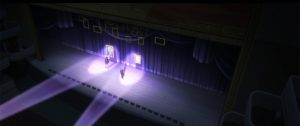 But then along comes Claudine, someone just as dedicated to the stage as Maya is. Someone who challenged Maya directly on the first day they met. Yes, Claudine had a bit of a shock when she found that Maya was her equal and maybe more, but we learned near the end of the series that Maya remembered being impressed by Claudine, as well, on their first meeting.
But then along comes Claudine, someone just as dedicated to the stage as Maya is. Someone who challenged Maya directly on the first day they met. Yes, Claudine had a bit of a shock when she found that Maya was her equal and maybe more, but we learned near the end of the series that Maya remembered being impressed by Claudine, as well, on their first meeting.
Now, the two finally recognize that yes, they are each other’s true rival. That no one else they’ve ever met compares to each other. And Maya in particular finds she has to truly go all out to compete with Claudine. I love that trio of lines they say to each other:
For heroes, there are trials.
For saints, there are temptations.
For me, there is you.
My mind is pulled off to Hercules and Odysseus and Joan of Arc. Epic figures in history that now Maya and Claudine count themselves among. It’s pretty freaking cool!
 There’s another little part of this Revue that I missed the first time. When Maya and Claudine are playing their little board game, Claudine admits that she had lost her love for the stage. She says she was dying inside because she had enjoyed working under Maya so much that she didn’t want to seek out her next stage. This adds some interesting context to Claudine’s part of the Revue. Her desire to have Maya acknowledge her as a true rival is rooted back in the way she almost became content with being in second place during their episode 10 Revue duet.
There’s another little part of this Revue that I missed the first time. When Maya and Claudine are playing their little board game, Claudine admits that she had lost her love for the stage. She says she was dying inside because she had enjoyed working under Maya so much that she didn’t want to seek out her next stage. This adds some interesting context to Claudine’s part of the Revue. Her desire to have Maya acknowledge her as a true rival is rooted back in the way she almost became content with being in second place during their episode 10 Revue duet.
But now, we get a renewed Claudine who, for the first time ever, was able to beat Maya. It was important for Maya to come to terms with her feelings of stoicism and importance, but it was just as important for Claudine to rekindle that spark of competition within herself. By the end of the Revue both Maya and Claudine are truly ready to seek out their next stage and even ready to fight each other as friendly rivals for future roles.
Oh yeah… and that musical callback to Karen and Maya’s Revue of Pride right as Maya and Claudine run at each other… that was amazing! Another great callback was the way Claudine and Maya did their final dramatic introductions of themselves after switching to their Revue uniforms. Each is parroting and mocking the other’s introductions they gave from the latticework of the Tokyo Tower on the Stage of Fate before their Revue in episode ten against Karen and Hikari.
The Final Lines
 And finally, we come back around to Karen and Hikari. This Revue is certainly the most abstract of them all. It’s also one that most directly challenges where things left off in the anime. In some ways, it even reverses some of the strongest positions espoused by the main series.
And finally, we come back around to Karen and Hikari. This Revue is certainly the most abstract of them all. It’s also one that most directly challenges where things left off in the anime. In some ways, it even reverses some of the strongest positions espoused by the main series.
All throughout the movie we’ve been seeing flashbacks of how Karen came to truly love the stage and how her promise with Hikari went from a child’s simplistic promise to a driving force in her life. It wasn’t just a fleeting promise, it was something that Karen held onto tightly for more than thirteen years as she grew from a child to an adult. Was Karen a little naive? Sure. But her faith in her promise was rewarded in the end.
What this Revue points out is that no matter how heartwarming it was in the anime when Karen said, “My stage is you, Hikari,” it was also a deeply flawed position. I love how they showed how incredibly grateful Karen was to Hikari for giving her the inspiration to join school plays and train in dance and acting and to join Seisho Music Academy. But also how they showed just how solely focused Karen was on Hikari to a ridiculous extent.
That scene where both Karen and Hikari turn to the audience watching them is fantastic. It’s a great fourth wall breaking callback to the Giraffe addressing us, the anime viewers, directly in the final episode of the series. Karen made it clear that all this time she barely even noticed the trials and hardships everyone was going through on stage. She never noticed the audience appraising and criticizing her performances. She never noticed the stage lights or any of the other technical challenges that come with acting on a stage. She never even noticed how scared everyone was to be putting themselves out in front of an audience. She ignored all of that because she was so focused on being in a position to do Starlight with Hikari…
…but now they’ve done it. They performed the lead roles in a play of Starlight. Mission accomplished. But, because Karen is as simpleminded as she is, she never thought beyond that point. The anime conveniently never addressed what comes next. It just gave us a happy ending. I love that the movie moves a step beyond and asks: “…and then what?”
What happens next is Karen realizes she doesn’t know what to do. In her perfect world, she and Hikari would be side by side forever. In the real world, Hikari went back to her home in London. In the real world, Karen is a brilliant actress who expected to always have her best friend by her side and now doesn’t. Karen feels dead inside because of all this. She just recently had the time of her life. She did the one thing she’d been looking forward to all her life… but it’s over now and she has nothing else she wants to do.
 So what fixes Karen? Well, for one thing, Hikari makes a pretty stunning admission. When they were watching Starlight as children, little child actress Hikari was so in awe of it that she was afraid that she might not ever reach that level. So afraid that she nearly gave up, in fact! It took Karen’s dumb raw idealism and the insistence that they promise each other to do their own Starlight to snap Hikari out of it. If Karen hadn’t been there, Hikari might have given up on being a Stage Girl all the way back when she was five. That’s a pretty awesome revelation! It helps give Karen some amount of fulfillment that her promise wasn’t just an empty thing for herself. She unknowingly saved Hikari way back then!
So what fixes Karen? Well, for one thing, Hikari makes a pretty stunning admission. When they were watching Starlight as children, little child actress Hikari was so in awe of it that she was afraid that she might not ever reach that level. So afraid that she nearly gave up, in fact! It took Karen’s dumb raw idealism and the insistence that they promise each other to do their own Starlight to snap Hikari out of it. If Karen hadn’t been there, Hikari might have given up on being a Stage Girl all the way back when she was five. That’s a pretty awesome revelation! It helps give Karen some amount of fulfillment that her promise wasn’t just an empty thing for herself. She unknowingly saved Hikari way back then!
The other thing that fixes Karen is the thing that always fixes Karen: The idea that she can be reborn as a Stage Girl and face the next challenge. Karen, lovable as she is, is kinda a dummy who often does the right things without realizing the deeper why. I think Hikari’s revelation jumpstarted Karen and caused her to look back on all the fun and challenging times she had as a Stage Girl growing up. It caused Karen realize that, no, her stage was not just Hikari. Sure, doing Starlight with Hikari was a huge goal, but Karen was a real Stage Girl and a star long before she and Hikari met again at the start of the anime.
We see a scene where Karen’s three past selves deliver a tomato to her comatose self. The tomatoes all throughout the movie have represented the willingness and desire and sacrifice to take on the challenge of continuing to be a Stage Girl. Karen had ignored that tomato and walked away from those challenges, but now she had it back in hand. So, Karen goes back to the beginning. We literally see her become Position Zero. She has to ride through her brief storm of insecurity and doubt, but she comes through it just fine and is once again reborn as herself, but now she clearly remembers and cherishes everything it took to reach this point.
After all that, Karen’s post-transformation introduction is forward looking to new stages instead of being focused on the stages of Hikari and the Starlight play. Karen now realizes one last thing that she never even considered before. Now that she and Hikari are going their separate ways, they might just end up competing against each other for the same role. Up until now, Karen has maintained that they could pass their Starlight auditions together. Now, Karen realizes that if she ends up going against Hikari she will want to win. It’s Karen’s last step to becoming a true Stage Girl. And yes, this newfound desire to be the best rips apart Karen and Hikari’s Promise Tower, but the promise had already been fulfilled. It will always be great memory the two will share, but it cannot hold up to the reality of the new stages they are heading towards.
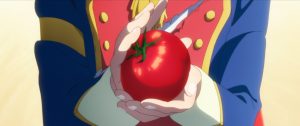 This is quite the departure from the series. It drags Karen a bit more into the real world. One where she knows she might have to defeat others in order to get the roles she wants. Even so, I think Karen will still be the lovable goofball who immediately came to check on and praise Junna for a job well done after their second Revue together. Karen will now try to win, but she won’t seek to destroy her opponents like some stars sometimes do.
This is quite the departure from the series. It drags Karen a bit more into the real world. One where she knows she might have to defeat others in order to get the roles she wants. Even so, I think Karen will still be the lovable goofball who immediately came to check on and praise Junna for a job well done after their second Revue together. Karen will now try to win, but she won’t seek to destroy her opponents like some stars sometimes do.
In the end, the top of the tower lands on Position Zero, and although Karen is empty from having accomplished her Starlight promise, Hikari tosses her a tomato. Karen can now fill herself up on the ambition of being a Stage Girl. She will be alright now, even as she moves into the real world beyond her childhood. And the movie ends.
Except it doesn’t! Stick around for the credits! We get to see where everybody ends up!
– Kaoruko inherits her position as the 12th Generation leader of the Senka-ryu dance school.
– Maya, Mahiru, and Futaba join the New National First Theater Troupe. (Maya can go anywhere she wants, I’m sure, but I’m a little surprised the other two got in!)
– Claudine joined the Theatre de Flamme in France. But, I’m thinking Maya came to visit at least once since Claudine has a cute little dove in her window.
– Junna did not go to a university literature department! She joined a New York Musical and Drama Academy and is dancing and having fun! Yay, Junna!
– And Banana? She joined the Royal Academy of Theatrical Actors… that’s where Hikari is studying! Maybe we can count on Banana (and Hikari?) giving that Judy Knightley, who ended Hikari’s quest to become a Top Star in the anime, a run for her money next time there are auditions? :p
– As for Hikari, she seemed to be traveling the world visiting her friends, but we last see her at her own Position Zero. There’s a ton of little hints throughout the movie that Hikari actually fully quit out of acting after doing Starlight with Karen, but now she is going back to it. I think it would be fun if she and Banana went from super rivals to best friends.
– And Karen? She has a new audition for a new role, but she’ll happily use her experiences of Starlight to help herself along! 🙂
Review: Astra Lost in Space
In Short:
Astra Lost in Space is a twelve episode anime released by studio Lerche in 2019. Set in a future where faster than light travel is common, the show follows a group of high school students who are frighteningly transported from the surface of one planet into orbit above a distant unknown world by a strange energy sphere.
They should be dead, but because they were still wearing their all-purpose space suits after being dropped off at the start of their “planet camp” field trip, they are able to board a derelict spaceship drifting nearby which they soon name the Astra.
Safe, but with barely any food or water, the group must survive interpersonal conflicts, technical and environmental challenges, and a surprising amount of intrigue as they chart a months long, planet hopping course back home.
Suggested Watch Minimum: 2 episodes. Astra Lost in Space has a story that unfurls quite a bit as it goes, but the second episode is a good place to judge the show since it forms the basic template the rest of the series follows.
Full Review:
 Astra Lost in Space is one of my favorite anime of all time… which makes it funny that I’m going to start off this review by encouraging you to stick with it all the way to the end of the first episode. The first two minutes of the show are great. It starts with one of our nine main characters frightened and alone, tumbling out of control in their spacesuit above an unknown planet. The final third of the episode is really good, too, as we see our somewhat antagonistic group work together for the first time. But, for as great as this show is, it kinda starts off slowly. After the intriguing open that got me hooked, the next twenty or so minutes had me growing more and more concerned for the show’s direction. They are filled with an odd mix of goofiness and cliches and hijinks just seemed off. Instead of a cool space adventure that the opening promised, it felt like the show was going to be a dumb, goofy, slapstick comedy with no real core or purpose.
Astra Lost in Space is one of my favorite anime of all time… which makes it funny that I’m going to start off this review by encouraging you to stick with it all the way to the end of the first episode. The first two minutes of the show are great. It starts with one of our nine main characters frightened and alone, tumbling out of control in their spacesuit above an unknown planet. The final third of the episode is really good, too, as we see our somewhat antagonistic group work together for the first time. But, for as great as this show is, it kinda starts off slowly. After the intriguing open that got me hooked, the next twenty or so minutes had me growing more and more concerned for the show’s direction. They are filled with an odd mix of goofiness and cliches and hijinks just seemed off. Instead of a cool space adventure that the opening promised, it felt like the show was going to be a dumb, goofy, slapstick comedy with no real core or purpose.
Fortunately, that feeling turned out to be extremely misplaced. Once I got past those awkward twenty minutes in the spaceport, there was a good episode and a truly great show waiting beyond. So, what I’m saying is, stick with it. Even the first episode ends up being good, but you do need to wait until the second half before it really kicks into gear. Once it did, Astra Lost in Space went on to surprise me with a very strong cast of characters, a good amount of light sci-fi, and a fun, well written story that steadily grew more tense and interesting the further the show went on. Let’s get into each of those a bit.
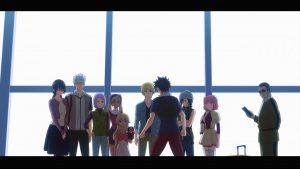 For characters, we have an ensemble cast with no real main character. Instead, we get nine individuals with drastically different personalities. They all have various strengths and weaknesses that come into play at different times throughout the series. Take Aries, the frightened girl we see in the show’s first few seconds. Turns out, when not fearing for her life, she is a bubbly, good-natured airhead, but she’s also someone whose strong sense of compassion and photographic memory are early keys to bringing the Astra’s misfit crew together. Or take Kanata, his “fake it until you make it” attitude and general goofiness are offset by his reliable leadership and world class athleticism, two qualities that save the day multiple times over.
For characters, we have an ensemble cast with no real main character. Instead, we get nine individuals with drastically different personalities. They all have various strengths and weaknesses that come into play at different times throughout the series. Take Aries, the frightened girl we see in the show’s first few seconds. Turns out, when not fearing for her life, she is a bubbly, good-natured airhead, but she’s also someone whose strong sense of compassion and photographic memory are early keys to bringing the Astra’s misfit crew together. Or take Kanata, his “fake it until you make it” attitude and general goofiness are offset by his reliable leadership and world class athleticism, two qualities that save the day multiple times over.
Without going into too much detail, Astra Lost in Space is a story where every character is essential, where several of the characters get a good bit of backstory, and where even their flaws are there for a reason. While the cast’s early banter and interpersonal conflicts can be a little annoying, they set the show up in a great position to see its makeshift crew slowly come together as a family by the end. It was a lot of fun watching these characters bounce off each other and change for the better as the series progressed.
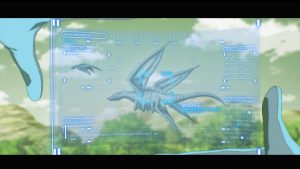 As a science fiction adventure, Astra Lost in Space is great. The core loop of the show is that in order to get home, the crew of the Astra needs to keep traveling to new worlds closer and closer to their end goal. They chart a course between habitable worlds that lets them go planetside and resupply their limited stores of food and water after each faster than light jump. The worlds they visit and the challenges they face are just good basic sci-fi. The show deals with things like alien ecosystems, micrometer strikes, natural disasters, and differences in gravity, but it does so in fun ways. This is a humorous adventure anime, not a science documentary, but the series still does a decent job on the science, too.
As a science fiction adventure, Astra Lost in Space is great. The core loop of the show is that in order to get home, the crew of the Astra needs to keep traveling to new worlds closer and closer to their end goal. They chart a course between habitable worlds that lets them go planetside and resupply their limited stores of food and water after each faster than light jump. The worlds they visit and the challenges they face are just good basic sci-fi. The show deals with things like alien ecosystems, micrometer strikes, natural disasters, and differences in gravity, but it does so in fun ways. This is a humorous adventure anime, not a science documentary, but the series still does a decent job on the science, too.
Finally, there’s the show’s overarching story of why these high school kids were transported into the cold, unforgiving vacuum of space in the first place. A lot of the early cliches and tropes and character oddities that feel like things you’ve seen in anime before actually matter as the story moves along. We have the main story of our nine crew members making their way back home, but the secondary story of what’s waiting for them there also comes into play part way through the series. Astra Lost in Space would make a pretty good sci-fi adventure if all it did was take our characters from one interesting planet to the next, but the way its various large and small plots fit together makes the series something special. There’s drama and sadness, but also some pretty nice moments of courage, humor, bonding, and forgiveness, as well. For a show that is largely a lighthearted adventure, the amount of stuff I can’t even hint at in this part of the review for fear of giving away spoilers is fairly extensive!
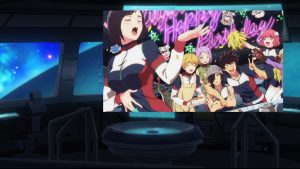 Graphics wise, Astra Lost in Space is decent, but not stellar, if you’ll pardon the pun. Character designs are good, and the show has a nice colorful vibe to it, but things like movement and overall animation are typically fine but not overly compelling. There’s far worse shows than this one, but it won’t be topping any animation best of chart’s either. If I had to criticize anything specifically, I’d point out that the computer rendering of the Astra is just not as good as I wish it was. Planetes, which came out some sixteen years earlier, has better ship animation by far, and most of its ships are completely hand drawn.
Graphics wise, Astra Lost in Space is decent, but not stellar, if you’ll pardon the pun. Character designs are good, and the show has a nice colorful vibe to it, but things like movement and overall animation are typically fine but not overly compelling. There’s far worse shows than this one, but it won’t be topping any animation best of chart’s either. If I had to criticize anything specifically, I’d point out that the computer rendering of the Astra is just not as good as I wish it was. Planetes, which came out some sixteen years earlier, has better ship animation by far, and most of its ships are completely hand drawn.
Soundwise, Astra Lost in Space is good. Sound effects are good. Voice acting is good. And its music is good, as well. You do get some nice, varied, upbeat music for the action scenes. I also like the opening and closing themes. Maybe they aren’t super special, but, again, they’re nicely upbeat and pair well with their on screen animations. Oh, and keep an eye out for evolving opening and closing credits that change over time and add new elements as the crew encounters them. The closings, in particular, show fun little slices of the crew’s life in their offscreen downtime as they travel from planet to planet.
All In All:
Astra Lost in Space is a bigger and better science fiction adventure than it first appears. Its characters have more depth, its worlds have more science, and its story has more intrigue, drama, humor, and heart than you might expect from the first few episodes. And, somehow, it achieves all this without losing its sense of friendship, family, and fun.
 Illegal Cloning. Cruel parents. Attempted murder via wormhole. Political intrigue. World war. Planetary evacuation. An apocalyptic asteroid strike. Massive government coverup. Secret rewritten history. Royal assassinations. Yeah, I wasn’t kidding when I said the amount of things I couldn’t talk about were extensive!
Illegal Cloning. Cruel parents. Attempted murder via wormhole. Political intrigue. World war. Planetary evacuation. An apocalyptic asteroid strike. Massive government coverup. Secret rewritten history. Royal assassinations. Yeah, I wasn’t kidding when I said the amount of things I couldn’t talk about were extensive!
It’s pretty amazing how many quality character beats and story beats Astra Lost in Space manages to fit into the space of twelve episodes. Some of them, like the cloning plot, take quite a while to make it out into the open. The way the show slowly introduced one bad parent after another was pretty interesting, because in isolation, any one of those parents could be written as a typical absurdly bad anime parent. But, as more and more of the Astra’s crew was revealed to have had bad childhoods, it eventually became apparent that we were looking at a major plot point instead of cliched writing.
I think it might have been the smaller things that I appreciated the most, however. Like the way Aries’ photographic memory was introduced as a convenient solution during a chase scene, but then kept coming back to help solve more and more serious problems as the story went on. Or how Kanata’s uncaring father and tough physical training was the key to rescuing so many of the characters over the course of the show. The scene were he lifts Ulgar out of the water one-handed actually kinda got to me. All that training really did serve a purpose!
 Another fun detail that was really easy to miss were the Lucy Lum advertisements in the spaceport all the way back in the first episode. I wonder if anybody out there made the connection between those holographic posters and Yun-Hau’s appearance. I certainly didn’t.
Another fun detail that was really easy to miss were the Lucy Lum advertisements in the spaceport all the way back in the first episode. I wonder if anybody out there made the connection between those holographic posters and Yun-Hau’s appearance. I certainly didn’t.
But I think my favorite little thing the show did was revisit Kanata’s cheesy ultimate dive-bomb from the first episode. As noted up in the main review, that early scene in the spaceport almost turned me off the show, but by the end it was mirrored in one of the most tense and heartwarming moments in the entire series. That was pretty cool.
Anime Suggestions For A Ravenclaw
Your Name.
Your Name is pretty easily my favorite anime movie. It’s fantastically beautiful in both art and animation, has great characters, has some really well integrated music, and has a great premise. In it, two high school students living very different lives, a boy in the big city of Tokyo, and a girl in rural small town Japan, end up swapping bodies a couple of times a week. The juxtaposition between their lives, and friends, and budgets, and, yes, even genders, is just so much fun. At times, they have to pretend to be each other just so as to not disrupt their normal lives. Eventually, they have to solve a common problem together… separately… acting in each other’s place.
I was blown away by this movie when I first saw it a few years back. If you watch nothing else on this list, watch this one.
Wave, Listen To Me!
This is a fun show I stumbled upon just a year or two ago. It follows a woman with an energetic and often comically disastrous personality as she tries to make the best of her day to day life. She has this ability to think and talk a mile a minute as she examines and comments on whatever situation she’s gotten herself in.
She is recorded one night in a bar while complaining about her ex boyfriend to an older man she doesn’t know. The next day, she hears her meandering, alcohol-fueled rant played over the local radio station! She rushes to the station to complain only for this older man, who turns out to be a radio station producer, to invite her to take a seat in the recording booth and apologize for her admittedly embarrassing rant on air! Which she does!
It turns out that this radio executive saw huge potential in her in that bar, and he recruits her to lead a late night radio show where she can use all her wit and improvisation and rapid fire thinking to tell stores and perform radio dramas and give silly life advice to callers based on their strange relationship questions.
Wave, Listen To Me! is a fantastic, fun, off-beat show that’s just a little different than anything else out there.
Time of Eve
This one is an interesting show set in the near modern day but where humanoid androids that serve as helpers and household assistants and the like are integrated into society. These androids are required by law to have a little holographic halo above their heads marking them as non-human, but there’s this one out of the way coffee shop called “Time of Eve” where the house rules allow androids to turn off that indicator. The rules also prohibit anyone from inquiring whether a person within the cafe is a human or not.
The show is centered around two high school boys who repeatedly visit the cafe and encounter a variety of different people with different personalities. Some of the people are obviously androids. Some of them are obviously not. And some of the peoples’ statuses are delightfully unclear. The interactions between our two main characters and the cafe’s patrons, each of whom get a fleshed out side story, are just wonderful. Sometimes the stories are endearing. Sometimes they are funny. And sometimes they are tragic. It’s such a great concept that is executed extremely well.
Oh, and you’ll want the movie version instead of the mini-series version. The movie version has all the content of the mini-series, and just a bit more.
Amanchu!
This is one of a class of anime that I enjoy where the anime is about a real world activity and really, really knows its subject matter. For instance, there’s various sports anime about baseball or tennis or whatever that get all the details right. Amanchu! is about scuba diving.
In it, we get a shy, introverted girl who has just moved to a new town and started attending a new high school. When she is forced to join a school club, she gets invited to join the scuba club by a wonky, energetic girl who soon becomes her best friend.
I was forced into taking one final elective in college and somehow lucked out at being able to take a sponsored scuba diving course. It was a huge delight to find this anime, because it gets almost everything right. From how the scuba systems work, to the buddy system you use to make sure you and your buddy are safe while diving, to the utter joy it is to be under water and able to breath.
Though based around scuba diving, there’s certainly plenty of fun slice of life content, too. Silly moments and friendship building and all that. But the process of our main character learning to scuba dive is the main draw here.
Maquia: When the Promised Flower Blooms
One last movie. Maquia: When the Promised Flower Blooms is a tale that is both epic in scope but very personal in execution. The movie is set in a magical medieval world where the magic of the world has naturally all but faded to nothing. Mezarte, the dominate kingdom of this tale, has long made use of fantastic flying dragons to maintain its power over its neighbors… but these immortal dragons its troops ride into battle are slowly dying off. In an effort to maintain an advantage over its rivals, Mezarte invades the distant territory of a peaceful people called the Iorph. The Iorph live incredibly long lives, you see, where they barely age at all even over the course of a human lifetime. Mezarte invades, abducts a handful of the Iorph intending to marry them off to produce immortal heirs, and kills the rest.
Our main character, Maquia, is an Iorph who manages to escape the slaughter of her people. As she flees, she stumbles upon a newborn human baby trapped within the arms of his murdered mother. Their wagon just happened to be between the invading army and Maquia’s people. Though Maquia hasn’t even reached full maturity herself, she adopts this human child as her own. The rest of the story is about this virtually immortal girl caring for her son as he ages. The relationship Maquia has with her son changes dramatically over the years as he goes from a baby, to a boy, to a teenager, and beyond. At times, their relationship is heartwarming, but sometimes it is heartbreaking. It all surrounds the question of how do you be a mother to someone when they age and you don’t.
The movie is magical and beautiful and sometimes tragic and sometimes thrilling. It is very well worth watching.
Review: Puella Magi Madoka Magica
In Short:
Released in 2011 by Shaft, Puella Magi Madoka Magica is a delightful take on the popular Magical Girl genre of anime. In it, young middle schooler Madoka Kaname and her best friend Sayaka Miki are approached by a cute magical creature who offers to make a contract with them. It will grant each of them any single wish they desire, but in exchange they must defend their city against monster-like Witches. Although it can be a dangerous job, love and friendship are shown to be the keys to winning the day.
Some of the Witches, and the distorted magical labyrinths in which they reside, can appear fairly frightening at first in contrast to the abounding level of wholesomeness the rest of the show puts forth.
Suggested Watch Minimum: 3 episodes. Although Madoka Magica is highly reflective of past Magical Girl shows, it’s not until the end of the third episode that you get a full feel for where it is going and what makes it different from its predecessors.
Full Review:
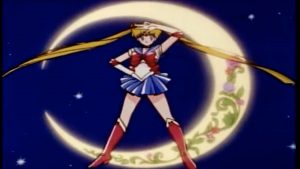 For myself and many others, the Magical Girl genre was how we were first introduced to anime. My first anime, whether or not I really knew it as anime back then, was the original 1992 English dub of Sailor Moon. In a Magical Girl anime, you typically have a clumsy or naive main character who comes in contact with a knowledgable mentor in the form of a cute magical animal. That mentor reveals that the main character is destined to have great hidden power or the ability to somehow fight evil if only they would unlock it. In a moment of crisis, the main character manages to transform in a flashy, highly detailed Henshin (Japanese for “transformation”) that usually gets repeated at least once per episode and uses their magical powers to defeat what is usually a monster or villain of the week. Making friends to fight along side and defeating evil are two of the most common aspects of Magical Girl shows.
For myself and many others, the Magical Girl genre was how we were first introduced to anime. My first anime, whether or not I really knew it as anime back then, was the original 1992 English dub of Sailor Moon. In a Magical Girl anime, you typically have a clumsy or naive main character who comes in contact with a knowledgable mentor in the form of a cute magical animal. That mentor reveals that the main character is destined to have great hidden power or the ability to somehow fight evil if only they would unlock it. In a moment of crisis, the main character manages to transform in a flashy, highly detailed Henshin (Japanese for “transformation”) that usually gets repeated at least once per episode and uses their magical powers to defeat what is usually a monster or villain of the week. Making friends to fight along side and defeating evil are two of the most common aspects of Magical Girl shows.
For Sailor Moon, the main character was Usagi Tsukino, a very clumsy and whiny middle school student who one day encounters Luna, a talking black cat. Luna reveals that Usagi is really Princess Serenity of the magical Moon Kingdom. With her true self revealed, Usagi is able to transform into the magical warrior Sailor Moon and fight to defend Earth against various evils along side other magical Sailor Scouts who soon become her friends.
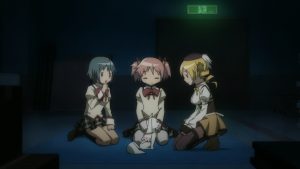 Released almost two decades later, Puella Magi Madoka Magica is a continuation of the Magical Girl genre first popularized by Sailor Moon. Our main hero, middle school student Madoka Kaname, is approached by the cute telepathic animal Kyubey who offers to make a contract with her. In exchange for helping to protect her city from “Witches”, hidden monsters who prey on ordinary people, Kyubey promises to grant Madoka any single wish she desires.
Released almost two decades later, Puella Magi Madoka Magica is a continuation of the Magical Girl genre first popularized by Sailor Moon. Our main hero, middle school student Madoka Kaname, is approached by the cute telepathic animal Kyubey who offers to make a contract with her. In exchange for helping to protect her city from “Witches”, hidden monsters who prey on ordinary people, Kyubey promises to grant Madoka any single wish she desires.
One of the things that makes Madoka Magica a worthwhile take on the genre, instead of a rehash of old ideas, is that Madoka does not become a magical girl by the end of the first episode as is so often the case with these type of shows. Instead, kind hearted Madoka and her friend Sayaka Miki, who has a strong sense of justice, hold back their wishes and team up with upper classman Mami Tomoe, their city’s most powerful Magical Girl, to see what it’s like to be a Magical Girl.
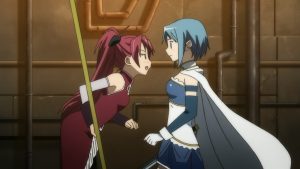 For the first few episodes, Mami explains to the two friends how being a Magical Girl is a great thing in that you get to save people and make the city safe. But Mami also touches on the more dangerous side of become a Magical Girl. That it’s not always fun and games, and that if you are going to exchange a single wish for the responsibility for keeping the city safe, you need to make sure your wish is a good one.
For the first few episodes, Mami explains to the two friends how being a Magical Girl is a great thing in that you get to save people and make the city safe. But Mami also touches on the more dangerous side of become a Magical Girl. That it’s not always fun and games, and that if you are going to exchange a single wish for the responsibility for keeping the city safe, you need to make sure your wish is a good one.
As the show progresses we also meet Kyoko Sakura, a more rowdy Magical Girl whose carefree attitude butts heads with Sayaka’s sense of justice. And we meet Homura Akemi, a cold, aloof Magical Girl who, for some reason, wants to keep Madoka from making her wish with Kyubey.
 It’s these relationships and conflicts, all of which circle Madoka in one way or another, that really drive the show. In the end, it’s Madoka’s selfless sense of kindness that wins her friends over and saves the day. But along the way, there’s all sorts of great dialogue and outstanding character moments and some pretty interesting fights against the highly varied Witch monsters.
It’s these relationships and conflicts, all of which circle Madoka in one way or another, that really drive the show. In the end, it’s Madoka’s selfless sense of kindness that wins her friends over and saves the day. But along the way, there’s all sorts of great dialogue and outstanding character moments and some pretty interesting fights against the highly varied Witch monsters.
As a Magical Girl show, Madoka Magica wears its influences on its sleeve. From the cute episode opening and main theme, to the way Madoka wakes up in the morning, to the emphasis on the power of friendship, this show clearly knows the various tropes of the Magical Girl genre and hits on pretty much all of them. Even it’s main title graphic is highly reminiscent of past Magical Girl shows. But don’t let that fool you. Madoka Magica has a lot to offer even for someone who has seen past shows in the genre.
Graphics and Sound:
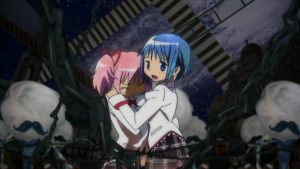 Though it doesn’t have the sharpest, most on-point animation, Madoka Magica still does a good job of getting its characters and situations across to the viewer. Though details can sometimes be a bit rough, the show manages to put forth a striking scene when it needs to. In particular, the show’s use of mixed media and stop motion animation for the Witches Labyrinths is particularly interesting and gives the fights against the otherworldly creatures an extra bit of creepiness. Artistically, the vision is there, but whether it was intentional or not, the actual animation in Madoka Magica is a bit… sloppy. I’d highly encourage you to track down the Blu-ray version of the show since many scenes received a fresh coat of paint and extra background details that make things feel more fleshed out and lived in.
Though it doesn’t have the sharpest, most on-point animation, Madoka Magica still does a good job of getting its characters and situations across to the viewer. Though details can sometimes be a bit rough, the show manages to put forth a striking scene when it needs to. In particular, the show’s use of mixed media and stop motion animation for the Witches Labyrinths is particularly interesting and gives the fights against the otherworldly creatures an extra bit of creepiness. Artistically, the vision is there, but whether it was intentional or not, the actual animation in Madoka Magica is a bit… sloppy. I’d highly encourage you to track down the Blu-ray version of the show since many scenes received a fresh coat of paint and extra background details that make things feel more fleshed out and lived in.
Soundwise, Madoka Magica is excellent. The song that plays alongside the opening is bouncy and delightful. And the general episode music has a nice flair to it. One of my favorite tracks, Credens justitiam, which plays during Mami’s first transformation sequence is a great cross between a latin hymn and an upbeat personification of the power of friendship and justice. Other tracks within the show do a great job of setting the mood, as well. The music in Madoka Magica is provided by top anime composer Yuki Kajiura and is some of her most outstanding work yet recorded.
Subtitles vs English dub can go either way. Both are very well done with great voice actors giving life to their characters. It really comes down to your own preference as to which one you listen to.
All In All:
Madoka Magica is a refined take on the Magical Girl genre that easily distinguishes itself from past series. It’s universal themes of friendship and justice are paired with enough wrinkles to keep things fresh and interesting. And it’s soundtrack is epic and memorable.
That’s all to say, there’s a reason Puella Magi Madoka Magica is well regarded as one of anime’s top Magical Girl shows.
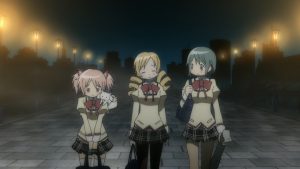 The reason Puella Magi Madoka Magica is well regarded as one of anime’s top Magical Girl shows isn’t actually its delightfulness or homages to the past. Instead, it owes much of its fame to much darker things. (If you haven’t watched up through episode 3 yet, stop and go do that before reading further.)
The reason Puella Magi Madoka Magica is well regarded as one of anime’s top Magical Girl shows isn’t actually its delightfulness or homages to the past. Instead, it owes much of its fame to much darker things. (If you haven’t watched up through episode 3 yet, stop and go do that before reading further.)
Fans of the Magical Girl genre will already be feeling that things aren’t quite right throughout the first three episodes. The emphasis on the tension of choosing a good wish. The warnings Mami gives about protecting the city as a Magical Girl not being fun. The feeling of impending doom that rises any time Homura appears. It all points to something being off the norms for the genre…
…and then at the end of episode 3, Mami is unceremoniously killed and eaten by a Witch she thought she had defeated!
 The shock that reverberated through the anime community by the end of the third episode is almost the stuff of legends. And, it’s something many of us who love the show try to preserve for newcomers as best we can. Going in thinking Madoka Magica is very nearly a typical, upbeat Magical Girl show only to slam into the episode 3 twist is something I’ve led friends into multiple times. And most of them loved it.
The shock that reverberated through the anime community by the end of the third episode is almost the stuff of legends. And, it’s something many of us who love the show try to preserve for newcomers as best we can. Going in thinking Madoka Magica is very nearly a typical, upbeat Magical Girl show only to slam into the episode 3 twist is something I’ve led friends into multiple times. And most of them loved it.
What at first seemed to be a delightful if somewhat out of the ordinary take on the Magical Girl formula is suddenly transformed into someone else entirely. Something darker. Something even more interesting. From episode 4 on, Madoka Magica concerns itself with what drives people to be Magical Girls, the perils of exchanging a single wish for a dangerous, unending responsibility, and what happens if your cute magical mascot is not the innocent benevolent creature it usually is in these kinds of shows.
In reality, Puella Magi Madoka Magica has two main strengths: Its characters, and the horrifyingly cruel situation they are put in by their supposed mentor and helper Kyubey.
 In most Magical Girl shows, the small magical mascot animals that first grants the girls their powers become one of the girls’ closest friends. They stay with their appointed girl during their daily routine. They are invisible to others giving the girl someone to talk to about the challenges of being a Magical Girl. And they are caring and highly protective of their Magical Girls, often going so far as to defend their charge as best they can if the going gets rough. Kyubey fulfills all of those aspects… except the last ones. Instead of caring about the Magical Girls it makes a contract with, Kyubey is at best indifferent to their fates. In reality, Kyubey actively leads the girls to disaster through both its actions and inactions.
In most Magical Girl shows, the small magical mascot animals that first grants the girls their powers become one of the girls’ closest friends. They stay with their appointed girl during their daily routine. They are invisible to others giving the girl someone to talk to about the challenges of being a Magical Girl. And they are caring and highly protective of their Magical Girls, often going so far as to defend their charge as best they can if the going gets rough. Kyubey fulfills all of those aspects… except the last ones. Instead of caring about the Magical Girls it makes a contract with, Kyubey is at best indifferent to their fates. In reality, Kyubey actively leads the girls to disaster through both its actions and inactions.
Mami Tomoe’s death early on is the first big twist of the show. It is a harsh wakeup call telling you that Madoka Magica won’t be like other, more wholesome Magical Girl shows. But, it’s not the last surprise the show has in store. Instead of Madoka Kaname becoming a Magical Girl and using the power of friendship and love to defeat evil, Puella Magi Madoka Magica is actually about preventing Madoka from making her contract with Kyubey in order to try and save her from the grotesque, horrifying fate that, by design, awaits all Magical Girls.
 You see, Kyubey is actually a member of an alien race that call themselves Incubators. They are logical and emotionless and something of a hive mind to the point that they see human individuality and emotion as a sickness. They probably wouldn’t deal with us at all except they have a higher purpose. It’s their goal to save the universe from the restless force of entropy by harvesting an unending supply of energy from the Magical Girls that they create.
You see, Kyubey is actually a member of an alien race that call themselves Incubators. They are logical and emotionless and something of a hive mind to the point that they see human individuality and emotion as a sickness. They probably wouldn’t deal with us at all except they have a higher purpose. It’s their goal to save the universe from the restless force of entropy by harvesting an unending supply of energy from the Magical Girls that they create.
It turns out that the Witches that Mami and all other previous Magical Girls have been fighting have actually been the twisted forms of past Magical Girls who gave in to and were driven mad by their despair. Kyubey collects the energy generated by the transition from hope to despair without really caring about what it’s doing to the girls it makes a contract with.
 With that big reveal later in the series, suddenly all the efforts that Homura Akemi has taken to try and prevent Madoka from becoming a Magical Girl begin to make sense. Instead of a cold, uncaring person, Homura is shown to have become a Magical Girl expressly to save Madoka from her fate no matter how many tries it takes. Each time Homura fails, she travels back in time to try again and again and again. By the time the show starts, Homura has been stuck in this weeks long loop for over a hundred cycles. Her harsh, aloof attitude isn’t because she is uncaring, its because she cares so much that she has already exhausted every kinder, gentler approach to saving Madoka!
With that big reveal later in the series, suddenly all the efforts that Homura Akemi has taken to try and prevent Madoka from becoming a Magical Girl begin to make sense. Instead of a cold, uncaring person, Homura is shown to have become a Magical Girl expressly to save Madoka from her fate no matter how many tries it takes. Each time Homura fails, she travels back in time to try again and again and again. By the time the show starts, Homura has been stuck in this weeks long loop for over a hundred cycles. Her harsh, aloof attitude isn’t because she is uncaring, its because she cares so much that she has already exhausted every kinder, gentler approach to saving Madoka!
Along with Homura’s unending task are the tragic stories of Sayaka and Kyoko. The way these two first clash and later gain some sense of understanding of each other fleshes out the show so much. Sayaka’s initial sense of justice is understandably dashed when she finds out that she’s just being manipulated as a tool for a greater purpose. And, oddly enough, it’s the somewhat mean spirited, carefree, anything goes Kyoko that tries the hardest to save Sayaka from her downward spiral into despair.
 One of my favorite things about Madoka Magica is that its turn from delightful to cruelly tragic was all planned from before the beginning. All the teasers and trailers released for the series before it aired showed your typical candy-coated Magical Girl series. The initial ending theme for the first two episodes is light and happy only for the ending to be swapped out for a dark and ominous sequence by the third episode. Once you get far enough in to the show, even the lyrics to the opening song take on a new, darker meaning. Astonishingly, the production actually went so far as to hide the involvement of its co-creator and writer Gen Urobuchi from audiences since he was well known for going dark with his past works.
One of my favorite things about Madoka Magica is that its turn from delightful to cruelly tragic was all planned from before the beginning. All the teasers and trailers released for the series before it aired showed your typical candy-coated Magical Girl series. The initial ending theme for the first two episodes is light and happy only for the ending to be swapped out for a dark and ominous sequence by the third episode. Once you get far enough in to the show, even the lyrics to the opening song take on a new, darker meaning. Astonishingly, the production actually went so far as to hide the involvement of its co-creator and writer Gen Urobuchi from audiences since he was well known for going dark with his past works.
This purposeful deception on the part of the show’s creators, combined with the legitimately awesome story and characters are the real reason that Puella Magi Madoka Magica is held up as one of the best of the Magical Girl genre. This is one of those shows that doesn’t waste a moment. Every episode matters. Every action the characters take is important. But, maybe the best thing that the show does is that after all the grief and suffering it puts its characters through, it still remembers what it means to be a true, ideal version of a Magical Girl. It’s right there in the title. Magical Girl Madoka Magica. It turns out that the show wasn’t all one big elaborate lie. It just takes its sweet, delicious time building up to the things it initially promised. By the end of the series, Madoka finally makes her wish with Kyubey and becomes a Magical Girl. With the full knowledge of all the terrible things that came before, Madoka is able to make a perfect wish and embody the true spirit of a classic Magical Girl in breathtaking fashion.
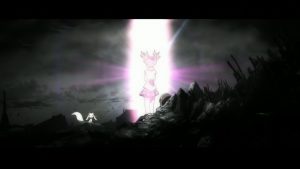 It’s this great moment where the series loops back on itself. After having shown just how horrible it is to trick young girls into fighting and dying and giving in to despair, the series is able to show us that the power of love and friendship and selflessness can win the day. The writing and pacing skills it took to pull that off along with a major time travel plot and along with multiple big, jaw dropping twists is truly remarkable. Because of all that, I’m of the opinion that Puella Magi Madoka Magica has one of the best stories and perhaps the best, most well supported, most perfect ending of any anime out there…
It’s this great moment where the series loops back on itself. After having shown just how horrible it is to trick young girls into fighting and dying and giving in to despair, the series is able to show us that the power of love and friendship and selflessness can win the day. The writing and pacing skills it took to pull that off along with a major time travel plot and along with multiple big, jaw dropping twists is truly remarkable. Because of all that, I’m of the opinion that Puella Magi Madoka Magica has one of the best stories and perhaps the best, most well supported, most perfect ending of any anime out there…
…which is gonna make things a bit awkward when we talk about the follow up movie, Rebellion.
Review: Spice and Wolf Anime
In Short:
Spice and Wolf is a 2 season, 24 episode anime from 2008 that is adapted from a long running series of light novels and manga. It tells the story of traveling merchant Kraft Lawrence and his companion Holo, a haughty yet clever wolf goddess who travels along side him in human form. In addition to bushels of downright excellent banter between its two leads, Spice and Wolf puts medieval economics front and center throughout its four main story arcs in a way that, astonishingly, remains interesting and tension filled right to the very end.
Though Spice and Wolf’s art is never bad, it is fairly modest compared to most shows I recommend. Come for the great leads and interesting economics, not flashy scenes or outstanding effects. This is also an anime that, unfortunately, ends on a somewhat of a lesser arc and an abrupt cliffhanger. On the bright side, the light novel series and manga have long since been complete and are readily available in both Japanese and English, so the story can continue if you wish it to.
Suggested Watch Minimum: 2 episodes. One of Spice and Wolf’s most notable aspects, its banter between its two lead characters, doesn’t really begin in earnest until its second episode. I also think Lawrence and Holo’s conversation about wolves is worth seeing before you make a decision.
Full Review:
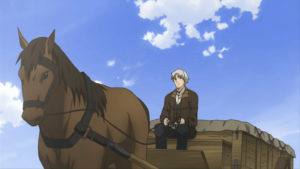 Spice and Wolf centers chiefly around Kraft Lawrence, an adult merchant in his prime who travels from town to town buying and selling a variety of wares in order to earn a living. Lawrence is an excellent business man and has a keen sense for making profitable deals, but he is also kind and personable, which tends to earn him the favor of most people he does business with.
Spice and Wolf centers chiefly around Kraft Lawrence, an adult merchant in his prime who travels from town to town buying and selling a variety of wares in order to earn a living. Lawrence is an excellent business man and has a keen sense for making profitable deals, but he is also kind and personable, which tends to earn him the favor of most people he does business with.
At the beginning of the series, Lawrence stops to trade with the wheat producing town of Pasloe just as it is finishing its harvest. He gets to watch as they carry out one of their harvest traditions where the person who cuts the last stalk of wheat puts on a mask and pretends to be the ancient wolf goddess Holo. This goddess was said to have made a deal with the town many generations ago whereby she would grant them bountiful harvests in exchange for their patronage. In more recent times, modern farming tools and techniques have largely seen Holo forgotten, though the town still performs a few last traditions in her honor.
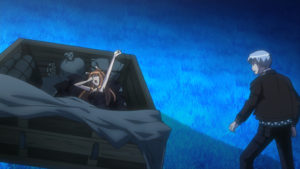 Lawrence feels an odd bump from the rear of his cart just as those last stalks of wheat are cut, but he quickly forgets about it as he interacts with the friendly residents. That night, however, on the road from Pasloe to the next town, Lawrence discovers what appears to be a young teenage girl sleeping naked in the back of his covered cart. When he wakes her he finds that she has the ears and furry tail of a wolf! This girl claims that she, in fact, is Holo the Wise Wolf and upon Lawrence’s insistence, she is able to prove it in dramatic and terrifying fashion!
Lawrence feels an odd bump from the rear of his cart just as those last stalks of wheat are cut, but he quickly forgets about it as he interacts with the friendly residents. That night, however, on the road from Pasloe to the next town, Lawrence discovers what appears to be a young teenage girl sleeping naked in the back of his covered cart. When he wakes her he finds that she has the ears and furry tail of a wolf! This girl claims that she, in fact, is Holo the Wise Wolf and upon Lawrence’s insistence, she is able to prove it in dramatic and terrifying fashion!
With the villagers no longer really upholding their end of their promise, Holo has decided it is time for her to move on from the town. She request that Lawrence allow her to travel with him as she makes her way back to her home in the north. What follows is the adventures of these two as they become traveling companions, business partners, friends, and perhaps something more.
 The relationship and banter between Lawrence and Holo is one of Spice and Wolf’s two main draws. While Lawrence is very adept at trade, he is a fairly straight-laced individual and often finds himself teased by the sometimes haughty, sometimes playful Holo. At the same time, Holo, who is some several hundred years old despite her youthful appearance, finds she has a lot to learn from the peddler she has decided to travel with.
The relationship and banter between Lawrence and Holo is one of Spice and Wolf’s two main draws. While Lawrence is very adept at trade, he is a fairly straight-laced individual and often finds himself teased by the sometimes haughty, sometimes playful Holo. At the same time, Holo, who is some several hundred years old despite her youthful appearance, finds she has a lot to learn from the peddler she has decided to travel with.
The range of topics and emotions the two engage each other with is fairly extensive, but more than that, it’s just so well done. They easily slip between discussing the practicalities of their plans in the next town, to goading each other with clever wordplay, to, at times, being put out or even hurt by one another in unexpected ways. It’s a little hard to describe, but despite one of the two being an immortal wolf goddess with a high opinion of herself, their conversations always have a feeling of reality and subtly to them that you don’t often get in even the best anime.
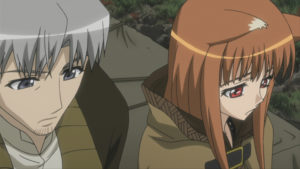 It actually took me a good two or three episodes to really understand Holo’s frequent teasing of Lawrence, but what’s great about it is that the same holds true for Lawrence within the show. At first, he is often cut short by Holo’s proud nature and the little verbal traps she playfully lays out for him, but as time goes on, he begins to learn what flatters her, what angers her, and, perhaps most importantly, how best to tease her back.
It actually took me a good two or three episodes to really understand Holo’s frequent teasing of Lawrence, but what’s great about it is that the same holds true for Lawrence within the show. At first, he is often cut short by Holo’s proud nature and the little verbal traps she playfully lays out for him, but as time goes on, he begins to learn what flatters her, what angers her, and, perhaps most importantly, how best to tease her back.
And for Holo’s part, she never claims any real amount of power or authority as a goddess, in her words she simply is who she is, and she and Lawrence are mostly equals in their relationship, but, over time, she learns to put her faith in Lawrence’s business sense and supports him as best she can. There’s also a slowly developing romantic tension between Holo and Lawrence that eventually sees them on largely the same page by the end of the series.
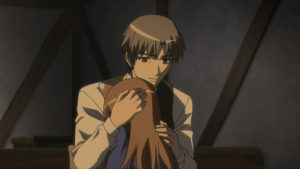 This progression between the two of them, from having a simple business arrangement to wanting to travel together above even their most deeply held dreams, plays out over the course of the show and just adds further to what makes them top tier characters.
This progression between the two of them, from having a simple business arrangement to wanting to travel together above even their most deeply held dreams, plays out over the course of the show and just adds further to what makes them top tier characters.
As the show progresses, we follow Lawrence and Holo through four main story arcs. Each one places a different challenge before the pair that test both their business sense and their growing feelings for each other. A lot of the time, the two have to work together to keep Holo’s true identity a secret. If the ever present church were to find out she is a pagan goddess, they would likely try to exorcise her or kill her in the name of the one true god. Holo poses as everything from Lawrence’s quiet business partner to his badly burned young wife so she can keep her wolf ears and tail hidden beneath her cloak. While keeping Holo’s identity a secret doesn’t play as large a role as the focus on finance and trade, it does come up from time to time in some interesting ways.
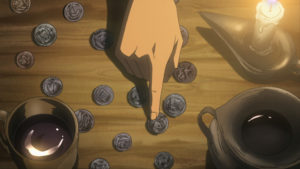 Spice and Wolf’s other core draw is its fascinating dedication to exploring medieval business and trade. Lawrence travels constantly from town to town trading one type of good, say furs, for another, such as apples. Though he almost always treats his clients with graciousness and respect, Lawrence does look to make the largest honest profit he can so as to one day fulfill a far off dream.
Spice and Wolf’s other core draw is its fascinating dedication to exploring medieval business and trade. Lawrence travels constantly from town to town trading one type of good, say furs, for another, such as apples. Though he almost always treats his clients with graciousness and respect, Lawrence does look to make the largest honest profit he can so as to one day fulfill a far off dream.
But now, with Holo at his side, Lawrence finds he has a business partner who is clever, thanks to her incredibly long life and innate resourcefulness, but who, because she had only dwelt near Pasloe for many generations, is also somewhat naive to realities of business dealings in the modern medieval world. This gives Lawrence the chance to explain things like the different worths of various silver coins and the reasons behind those differing values, or, how traveling merchants group together in guilds to protect and enhance each other’s good name. Though Holo may not understand a concept at first, she is often wise enough and quick-witted enough to catch on quickly. And, as she learns and explains new concepts to herself, we get to learn right along with her.
That I often think back to this anime when I hear about the real world valuations of currency, or import tariffs, or short selling stock, or trade negotiations is a credit to just how well Spice and Wolf handles the economic sides of its stories.
Graphics & Sound:
 As noted above, Spice and Wolf’s art and animation are, perhaps, the least of its draws. It has great backgrounds, great character designs, and doesn’t cheap out anywhere in particular. There’s just something with the direction in general and action scenes in particular that lack the fluidity and movement you might see in other anime. Still, the show does have good direction in general and some great shots of its cities that do a good job showing off their layout and scale.
As noted above, Spice and Wolf’s art and animation are, perhaps, the least of its draws. It has great backgrounds, great character designs, and doesn’t cheap out anywhere in particular. There’s just something with the direction in general and action scenes in particular that lack the fluidity and movement you might see in other anime. Still, the show does have good direction in general and some great shots of its cities that do a good job showing off their layout and scale.
As for sound and music, I have no complaints. The opening songs of each season are wonderful. They both have this sort of sad comfort and coziness which is very appealing. Its two closings are a good bit more playful which works great most times, though I think there might be a couple of instance where we cut from heavy tension to happy, upbeat engrish. While a bit jarring, it’s certainly not the worst offender I’ve ever seen, so I’ll give it a pass for its rare minor musical sins.
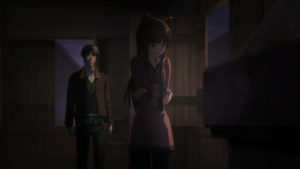 Finally, it takes good voice actors to pull off the wide ranging exchanges we get from Lawrence and Holo. Holo, in particular, can switch from feisty, to drunk, to introspective, to lonely, to appreciative all within the span of a single scene, and both her Japanese and English voice actresses pull off her various moods with aplomb! If you’re looking for a killer, best of anime performance, stick around until season 2 episode 3 where Japanese actress Ami Koshimizu kills it as Holo.
Finally, it takes good voice actors to pull off the wide ranging exchanges we get from Lawrence and Holo. Holo, in particular, can switch from feisty, to drunk, to introspective, to lonely, to appreciative all within the span of a single scene, and both her Japanese and English voice actresses pull off her various moods with aplomb! If you’re looking for a killer, best of anime performance, stick around until season 2 episode 3 where Japanese actress Ami Koshimizu kills it as Holo.
Lawrence is more subdued, most times, but he too goes through his fair share of emotions. If anything, we know that J. Michael Tatum, Lawrence’s English voice actor, has far and away more than enough range to pull off Lawrence thanks to his energetic, best of the best performance as Okabe Rintaro in Steins;Gate. Lawrence’s Japanese voice actor is pretty well regarded, as well, having started in a decent number of high profile roles. So, no matter how you watch it, Spice and Wolf is just a delight to listen to.
All In All:
Spice and Wolf somehow manages to combine great characters and conversations with explorations of medieval trade in a way that’s actually interesting and engaging. The relationship between Lawrence and Holo is very well regarded by anime veterans for good reason, and you don’t have to try hard at all to find someone who will jokingly claim that this anime helped them get through their economics classes.
 There are many, many good interactions between Lawrence and Holo throughout the series, but one of my favorite early ones is the conversation about wolves I mentioned at the first of this review. We get to see how Holo enjoys teasing Lawrence. She spins a little, playful folk tale about her kind not realizing that to Lawrence, a wolf attack is a deadly serious thing. We even see that Lawrence has lost traveling companions to wolves. That he’s seen them torn apart by them!
There are many, many good interactions between Lawrence and Holo throughout the series, but one of my favorite early ones is the conversation about wolves I mentioned at the first of this review. We get to see how Holo enjoys teasing Lawrence. She spins a little, playful folk tale about her kind not realizing that to Lawrence, a wolf attack is a deadly serious thing. We even see that Lawrence has lost traveling companions to wolves. That he’s seen them torn apart by them!
When Holo realizes what she’s done, she and Lawrence abruptly pause their banter for the entire time it takes them to pass through a village. For two companions that chat almost constantly, this long moment of tense silence is very powerful. When they emerge back into the countryside, Holo does the right thing and apologizes. It’s one of the first times that we see Holo as something more than a haughty, teasing goddess, and get to view her as a real person who can make mistakes.
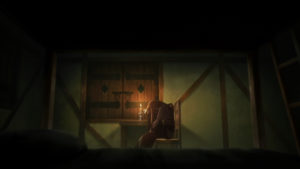 Though Holo is typically quite feisty, pay attention to the times when she isn’t. Her sense of loneliness, isolation, and the way she worries about her future even though she is effectively immortal are some of the things that elevate her to being one of my favorite characters in all of anime.
Though Holo is typically quite feisty, pay attention to the times when she isn’t. Her sense of loneliness, isolation, and the way she worries about her future even though she is effectively immortal are some of the things that elevate her to being one of my favorite characters in all of anime.
I’ll leave it to you, dear reader, to evaluate Lawrence and Holo’s relationship further. But, before I go, I’ll leave you with an interesting recommendation for another anime. If it turns out you liked the economics lessons of Spice and Wolf, go give Maoyu a try. It’s certainly the lesser of these two shows, but it was made by some of the same people and has a very familiar art style and aesthetic. Though not connected plot or character wise, the show relates to Spice in Wolf in the way it shows how a small medieval village is able to grow into a thriving city through the use of improved tools and techniques. You get explanations of things like crop rotations and trade deals and so on in much the same way Lawrence explains currency valuation to Holo.
Maoyu’s underlying plot and attempted romance between its leads never engages as well as anything in Spice and Wolf, but it’s still worth a watch for its economics lessons alone.



